#I wonder if this story will ever dive into Warrior's background
Explore tagged Tumblr posts
Note
Wild Card! Pick something on the need to write list ideas you might have!
You know what? I'm writing Part Two of Dragon! King! Time and no one can stop me. >:D
I'm writing this for me!!!
Masterlist
Part one
Content under the cut!
"Where are they?" A deep growl shakes the entirely of the castle. "WHERE ARE THEY?!"
"Your Majesty, please calm down before you destroy the castle." Warrior bite his lips, not at all excited for the conversation he is about to have.
"They are supposed to come every two weeks." The kings growls incessantly. "If I had marked them by now, I would at least have a hint at what happened to them. Are you sure they haven't showed up at the apartment?"
"Positive, sir." Warrior begins to feel a little sick to his stomach, and it's not because of the residue magic that's being leaked into the air by the Ancient King himself. "All the gifts you've had me drop off are... untouched."
"It's been over a month! Almost two! And not a single note or announcement-!"
"They're not home." Warrior stresses. "They-"
The king catches the slip up. His dietic magic flares through the atmosphere, setting all dragons in a 300 miles radius on edge. "Captain, are you aware of their whereabouts?"
"...Your Majesty, I beseech you to sit down first." Warrior growls, feeling his own magic begin to rise to the surface. Little puff of flame escape his mouth despite his best efforts. He knows he would never win in a fire against the King. He is the king for a reason. But that doesn't mean he's still not capable of dealing a lot of collateral damage in the process.
King Link of Kokiri Kingdom growls up a storm, cracking the windows of the throne room before begrudgingly sitting on his throne. "Proceed." 'With caution', need not be mentioned. "Where are they?"
Warrior steels his nerve, setting his palms on fire to lessen the magic build up in his body. "The hospital."
The glass windows explode from the magical flare. All objects lift off of the floor by three feet, Warrior included. And the King has shifted into his full dragon form, taking up the majority of the space in the room due to his massive size and power.
Warrior is dropped non to gently and wastes no time shifting to his full dragon form as well, breathing the hottest wall of fire he can to get the King's attention off of raging towards the nearest hospital. He chars the floor and tapestries on the process, but this is more important.
"You can't go!"
"watch me."
"You aren't supposed to reveal her identify to the public!" Warrior reminds him. "She works undercover for a start and we knew this work could potentially injure them."
"which hospital, captain?" The King hardly looks at him and very seriously begin to gauge which wall the castle needs the least. "i'm going to claim what's mine and never let anything else threaten them."
Warrior curses the instinctual possessiveness of dragons. It never seems to end well once a human gets involved. "You cannot barge in there like a raging bull in a china shop! You'll destroy any trust they have in you. They've just started getting comfortable in your presence."
That seems to calm down the king somewhat. Time growls but manages to contain his magic at once. "....i'd frighten them."
"Exactly." Warrior doesn't allow himself to breathe a sigh of relief just yet. But this is progress.
A very long and pregnant pause settles over the throne room. In a flash of light, the King returns to his half form, growling up a storm and not at all aware of the damage to the castle. "Blast it all!"
Warrior shifts to his human form and brushes off his uniform. He's aware that the people of the castle have been talking about the King's upsets. It wasn't so bad when you had missed the first visit. He was marginally upset, but understanding, expecting a message at some point to explain why you hadn't shown up. Two weeks later, with no correspondence, you missed the second one and King Time had all but sent out a search party for you.
By the third, he was about to go mad with drive to find you.
The kingdom has never seen their cool and collected leader in such a state. Many believe that you (despite not knowing much about you as a whole) have bewitched the King and had one of the most beings in the world in the palm of your hand.
Which... isn't entirely wrong, Warrior admits. But what they didn't know is that you would rather have anything else and are constantly rejecting the King's attempts to court you discreetly.
It hasn't stopped the King, mind you, hence the gifts, but Warrior has never seen a man more head over heels for the most oblivious person.
The King has yet to stop growling but he has calmed himself down to once again look at Warrior in the eye. "...What's their condition? How long have they been there?"
Warrior sighs. That's confidential information. But... he wouldn't have the position he has if he wasn't the best at his job. "They were checked into the emergency room two days after your last meeting with them. Emergency surgery was instantly approved and they have been in the hospital for the past month. I... believe that they should have been approved to return home about a three days ago, should my calculations be correct."
Magic flares up once more as the king's rage turns against Warrior. It is a frightening sight.
"YOU KNEW!?"
Warrior holds a hand up, ignoring how everything fiber in his being is raised by the shackles. "Because I knew that you would want to smother them all the same once I continue this report. If you would allow me to do so."
Magic continues to pulse through the air but the King hasn't returned to his full dragon form, so Warrior has hope. However, the King's growls shake Warrior to his core despite his grade A acting skills. "Proceed."
Warrior gulps. "They... were critically wounded, presumably on the job. I kept this information to this day to buy them time to both return home and heal."
"what wounded them?"
Warrior hesitates.
"captain link."
"Bullets, sir. They had three bullet wounds."
A ferocious roar shakes the shattered windows from their frames, raining the glass to the cracked floor below.
"WHO?!"
"I don't know..." Warrior admits softly. "We'll have to ask them when they return..."
Because you will return, right? To them? To King Link?
You were so full of life and spunk. There was no way that this would have kept you down for long. You were critical, yes, but even Warrior managed to garner that you would have a miraculous recovery. Warrior is willing to bet it was due to the King's residue magic of his claim. It is quite potent.
Time manages to make his way back to his throne and all but collapses into it. His hands are shaking. "....For all that is good and holy...."
Warrior finally swallows the thick cotton in his mouth. It's difficult. "Your majesty... We must allow them to come back on their own terms. I'm sure they will explain everything."
Time shakes his head. "I've... never felt strongly over another before. All those employed under my kingdom and certainly under my castle are mine... but they... I want them here. I want them safe. I want them to... I just want them near me. I want to mark them. It's getting harder and harder to keep myself in check."
"I can see that, sir." Warrior jokes flatly. Now is not the time. "We all can see that. With the exception of them."
"And they don't even accept the help I'm offering to their face!" Time laments. "The last time was infuriating! You heard it! Some upstairs neighbor- Some secret admirer! It's been me! But I can't say anything and I'm forced to keep my affections to myself."
Warrior bites his tongue and lets the King take the needed breather after nearly destroying the castle from the inside out.
"Tell me honestly, Link, how helpless am I?"
"Yes."
A beat passes and Time sighs, giving his long time friend a small smile. "Where I would be without you, Captain?"
"Destroying the one shot you have to genuine romance, your majesty." Warrior smiles gently in return.
Time bite his lip, discreetly pinching the bridge of his nose to wipe the tears. "Do you think they'll keep the schedule? If nothing had happened they would be due to visit in the next three days."
"I'm not sure, your majesty." Warrior says kindly. "But we can always hope and try to look after them from afar."
Those three days couldn't have passed fast enough.
King Time paced through the throne room with his tail lashing out wildly, unable to calm himself down enough to take a sit and be patient about this.
Warrior feared he would forget how to be gentle if the moment came to it. There was still work to be done, and reconstruction hadn't finished on the throne room when the appointment arrived but the workers were shooed away for the time being as the King waited.
Just when the King was about to give up and call it day to scheme his new plan to care for you, the clock struck the late hour.
And you came.
Part 3
#linked universe#linkeduniverse#linked universe x reader#lu x reader#dragon au#royal au#warrior is trying his best to run the kingdom#and be the kings right hand man#when the king himself is hanging on by a thread#he's about to *lose* it#both of them#I wonder if this story will ever dive into Warrior's background#doubt it
158 notes
·
View notes
Text


Original Warriors covers vs new covers, a tangential word vomit analysis by me: ORIGINALS Into the Wild really pulls you in. Who are they? Why does the one on the right look vicious? What's up here?
Fire and Ice is like, "Shit's going DOWN." The little square with Fireheart and Graystripe sitting for their vigil is beautiful. Love the moon. Love the difference in colors between the square and the battle in the background.
Forest of Secrets is breathtaking. It's easily one of my favorite book covers ever. Fireheart's back is exposed, the story dives into betrayal, and the cats crossing the stepping stones is ... just perfect.
Rising Storm with the hunting sequence and itty bitty fluffy lil baby Cloudtail. I wanna scoop him up and snuggle him and give him churus. The background looks beautiful. I want to go there. It contrasts well with the tension of one cat stalking another.
A Dangerous Path with that LIGHNTNING IN THE BACKGROUND omg middle school me was obsessed. That's the one I remember seeing my friend read and then I finally asked her what those books were. I remember thinking, "I can't wait to get to that book," because it was clear some big stuff was going on in it.
The Darkest Hour is so calm and really gives eye of the storm vibes, and Firestar seeing his reflection as a lion is beautiful and an excellent payoff.
NEW COVERS The new covers are like, "This is a cat," and that's about it. Great. Yeah, that's a cat. A pretty kitty, one might say.
Into the Wild's is okay. Rusty looks a bit baby-faced, as to be expected, and his eye is well-done. I like the grass, but also it looks like he's just popping up from it even though I feel like the intent is that he's supposed to be stalking through the foliage? On Fire and Ice's cover, I can tell that's Tigerclaw. Looks like the still shot of a villain in an anime while they're plotting their Evildoings and you can hear their inner monologue. But he also looks like a very old bearded man, for some reason. The little embers against the wintry background is a nice touch. Why is Forest of Secrets golden? Why is the river piss? Why is it sparkly? This does not invoke long-buried secrets being unearthed and changing lives, reputations, and social statuses. It has more of a "summer vacations that last forever" bright and pretty vibe. Rising Storm is ... eh. Red. Fiery. Okay. But the overly airbrushed, sparkly-eyed kitty doesn't show me that tensions are building. It just looks like kitty is doing a photoshoot for their Insta. I think that's Yellowfang?? A Dangerous Path is, like, where is that light coming from and why? Nothing here looks dangerous. The cat looks like it's being blinded. I don't even know which cat that's supposed to be. The forest background is dark to remind us that this is a DANGEROUS path but forests are dark at night and not inherently dangerous because they're dark. Aaannd then we get to The Darkest Hour. All they had to do was include a fucking lion somewhere. It would've been cool even if it was sitting behind Firestar. It doesn't look like he's looking at his reflection. It looks ... I don't even know. The water effect would work much better if it looked like it was rippling outward from somewhere? Instead, they made it look like the water is moving in an outline around his head, which doesn't make any sense. It's sourceless. Where does the movement start? Where is it going? I don't know. I can't tell.
The close-up face shots with little to nothing intriguing going on around the cats doesn't make me wonder anything about the story. It doesn't pull me in. There is so little space around them. It feels like when you wake up and you feel your cat's breath against your nose and their paw is in your mouth and they're yowling at you because they're STARVING and you're like, "Dude, I love you, but get out of my face." ty for reading my rant. please return to your regularly scheduled day. Have a good one.
edit: just wanted to toss out there that the artist of the new covers has amazing work in his portfolio, and my issue isn't with him nor his art as a whole, just that the direction (which is probably on the publishers' end) lacks "oomph" and doesn't do the drama in the Warriors series justice. Also, with as many books as there are in the series, it's important that each book's cover is distinct, and the newer covers don't quite hit that mark.
9 notes
·
View notes
Photo

From men being turned into flowers to a single fruit starting the Trojan War, there are many fascinating histories behind many plants and flowers in Greek mythology. Here are a few key plants and the intriguing mythology behind their names. In my herbal or flower guides, I’ll do a little dive into the history of the plant. Many have notes on Greek mythology, for plants were often the core of understanding the myth narrative. In fact, many of the plant’s properties are the small truth you’ll find at the centre of these myths. Ellen Zachos’s new book, Mythic Plants: Potions and Poisons from the Gardens of the Gods, details many of our favourite plants and the Greek mythology behind them. To say I’m excited about this book is an understatement. It’s available now for pre-order and will certainly be a best seller. Ellen is one of the most inquisitive and talented people I have met. If you have ever heard her talk, she fills the room with excitement and imparts knowledge in a way that feels like entertainment. And that’s what her writing is like as well. The words and stories pop off the pages, making it easy to learn and feel like she is sitting there with you, having a cocktail and conversation. If my mother was alive, Mythic Plants would have been her favourite book. In university, she was a history major, and then she took up gardening in retirement. She started taking some biology classes at the local college as her love of plants grew. As a lover of history and plants, I wish she could have read this book. If you also have a love of plants and diving deep into history, you’re going to love this book. I’ve gathered a few stories about plants in Greek mythology from Ellen’s book to share with you today that perfectly capture her wonderful storytelling! Quotes republished with permission from Mythic Plants: Potions and Poisons from the Gardens of the Gods by Ellen Zachos © 2025. Published by Workman Publishing. 7 Plants and Flowers of Greek Mythology Opium Poppy Papaver somniferum Many of us know the opium poppy for its sometimes infamous reputation as the origin of opioids. The Greeks knew it too as an anesthetic and a powerful tool in medicine, but also as the reincarnation of the goddess Demeter’s lover. “Demeter, goddess of the harvest, had a mortal lover named Mekon. She transformed him into a poppy to preserve his beauty after he died, and the poppy plant was henceforth called Mekon. That’s it. No trickery, no abduction, no drama,” says Ellen. It’s not often you get such a simple, drama-free story in Greek mythology. Demeter is known as the harvest goddess and is associated with many different flowers and fruits, so it’s no surprise to see the opium poppy connected with her. Ellen also notes that Demeter used poppy and its ability to “relax” as a way to settle down after the disappearance of her daughter, Persephone. More on that later! The opium poppy is beautiful and can be grown for ornamental purposes. Yarrow Achillea millefolium While it is easy to connect Demeter with plants in mythology, there can be other interesting figures with herbaceous backgrounds, such as the central character in Homer’s Iliad, Achilles. “While Achilles is well-known as ancient Greece’s fiercest warrior, few people realize he was schooled in herbalism by the centaur Cheiron, “ says Ellen. “One plant in particular remains associated with Achilles even today. The yarrow plant, Achillea millefolium, is named for Achilles, and mythology tells us he used it to heal his men on the battlefield.” Today, it is still known as a wound healer. During WWII, it was used to treat soldier’s wounds since it stops bleeding when made into a poultice and acts as an antiseptic and anti-inflammatory. It’s a favourite in my garden due to its drought-tolerant properties, beautiful array of colours, and the fact that the pollinators love it. Yarrow is a very low maintenance flower with colourful blooms. Fig Ficus carica Have you ever enjoyed the splendour of a fresh fig? There is really nothing like it out there, and it’s difficult to enjoy without growing one yourself or knowing someone who does. “The fig (Ficus carica) was so important in ancient Greece that there were special laws about who could harvest them and when,” says Ellen. “Sure, figs are delicious, but even more importantly, they are easily preserved by drying.” Being able to dry figs for winter made them extremely valuable, being one of the three most important agricultural crops behind grapes and olives in ancient Greece. As a vegetation god, Dionysus was often associated with figs, and the easy-to-carve fig wood was often used to make wooden phalluses for Dionysus rituals since he was also considered a sexual god. Ellen tells a particularly phallic myth about Dionysus and fig wood in her book. I’ll leave it to you to seek it out! My old garden had a Brown Turkey fig tree, from which I often enjoyed fresh figs. Rose Rosa spp. I’ve written plenty about the beauty of roses, as well as their medicinal properties. They’re an absolute skincare favourite of mine, and I use rose water nearly every day of my life. The Greeks also loved their roses, the climate being perfect for growing them. “The flower is soft, fragrant, voluptuous, and sensual. In contrast, its stem is painfully prickly and can draw blood. So it makes sense that the rose was sacred to Aphrodite, goddess of love, well-versed in both pleasure and pain,” says Ellen. The rose is also associated with Aphrodite’s son, Eros, and her lover, Adonis. Aphrodite was also said to use the medicinal properties of rose oil to cover the corpse and protect the skin of the Trojan warrior Hector, as Achilles dragged his body as an act of revenge—such a brutal story for a beautiful flower. Rose can help to tighten skin, reduce discolouration, even skin tone, and even help reduce wrinkles. Narcissus Narcissus spp. One of the heralds of spring, the narcissus (daffodil) is a cheery yellow flower with a darker Greek backstory. The flower was used by Hades to attract Persephone, the daughter of Demeter and Zeus, to a beautiful field. When she bent to pick the narcissus flower, the world opened beneath her, and Hades took her in to be his wife and queen of the underworld. “The beguiling narcissus was no earthly plant,” says Ellen. “It had been created specifically to lure Persephone away from her friends by the same god who approved the kidnapping plot: Persephone’s father, almighty Zeus.” While the Greeks may have seen the more nefarious side of the daffodil, I still appreciate the brightness it brings as winter slowly disappears. Lettuce Lactuca spp. Lettuce is always one of the first plants I recommend people grow. It’s super easy to start from seed and well worth the effort put into growing them. I grow mine in a wine barrel, feeding me all spring, summer, and fall. In terms of Greek mythology, lettuce doesn’t have the same praises. It was known as the deathbed of Adonis, Aphrodite’s beautiful lover. “Adonis died while still a boy, gored by a wild boar,” says Ellen. “Some say Ares sent the boar because he was jealous (he and Aphrodite had history). Others say the boar was sent by Apollo or Artemis as punishment for offenses Aphrodite committed against them. Regardless of whoever sent the boar, Adonis died on a bed of lettuce, and after that, lettuce was associated with death.” If you ask me, a bed of lettuce isn’t the worst place to go. Quince Cydonia oblonga I love flowering quince. It’s one of the flowers featured on my tattoo. While the flowering quince also produces an edible fruit, they’re technically a different genus (Chaenomeles speciosa) from the quince fruit. However, they’re both members of the family Rosaceae. “Today the quince is a novelty fruit, but in ancient Greece the quince was appreciated as a food, a valuable trade item, an aphrodisiac, and the central object in several well-known myths. In fact, the quince may have been the golden apple that started the Trojan War.” Yes, the Trojan War. This fact is up for debate, however, which Ellen breaks down in full in her book. Flowering quince. I hope you enjoyed some of these stories about plants and flowers in Greek mythology. Ellen’s book Mythic Plants covers more than 40 different plants in Greek mythology, diving deep into their history in such an engaging read. Available for pre-order now, I really hope you check it out! More Fascinating Plant History to Read Source link
#WATERING_SYSTEMS#FASCINATING#FLOWERS#FOLKLORE#GARDEN#GREEK#HISTORY#MONTH_DECEMBER_WEEK_4#MYTHOLOGY#PLANTS#THERAPY
0 notes
Photo

From men being turned into flowers to a single fruit starting the Trojan War, there are many fascinating histories behind many plants and flowers in Greek mythology. Here are a few key plants and the intriguing mythology behind their names. In my herbal or flower guides, I’ll do a little dive into the history of the plant. Many have notes on Greek mythology, for plants were often the core of understanding the myth narrative. In fact, many of the plant’s properties are the small truth you’ll find at the centre of these myths. Ellen Zachos’s new book, Mythic Plants: Potions and Poisons from the Gardens of the Gods, details many of our favourite plants and the Greek mythology behind them. To say I’m excited about this book is an understatement. It’s available now for pre-order and will certainly be a best seller. Ellen is one of the most inquisitive and talented people I have met. If you have ever heard her talk, she fills the room with excitement and imparts knowledge in a way that feels like entertainment. And that’s what her writing is like as well. The words and stories pop off the pages, making it easy to learn and feel like she is sitting there with you, having a cocktail and conversation. If my mother was alive, Mythic Plants would have been her favourite book. In university, she was a history major, and then she took up gardening in retirement. She started taking some biology classes at the local college as her love of plants grew. As a lover of history and plants, I wish she could have read this book. If you also have a love of plants and diving deep into history, you’re going to love this book. I’ve gathered a few stories about plants in Greek mythology from Ellen’s book to share with you today that perfectly capture her wonderful storytelling! Quotes republished with permission from Mythic Plants: Potions and Poisons from the Gardens of the Gods by Ellen Zachos © 2025. Published by Workman Publishing. 7 Plants and Flowers of Greek Mythology Opium Poppy Papaver somniferum Many of us know the opium poppy for its sometimes infamous reputation as the origin of opioids. The Greeks knew it too as an anesthetic and a powerful tool in medicine, but also as the reincarnation of the goddess Demeter’s lover. “Demeter, goddess of the harvest, had a mortal lover named Mekon. She transformed him into a poppy to preserve his beauty after he died, and the poppy plant was henceforth called Mekon. That’s it. No trickery, no abduction, no drama,” says Ellen. It’s not often you get such a simple, drama-free story in Greek mythology. Demeter is known as the harvest goddess and is associated with many different flowers and fruits, so it’s no surprise to see the opium poppy connected with her. Ellen also notes that Demeter used poppy and its ability to “relax” as a way to settle down after the disappearance of her daughter, Persephone. More on that later! The opium poppy is beautiful and can be grown for ornamental purposes. Yarrow Achillea millefolium While it is easy to connect Demeter with plants in mythology, there can be other interesting figures with herbaceous backgrounds, such as the central character in Homer’s Iliad, Achilles. “While Achilles is well-known as ancient Greece’s fiercest warrior, few people realize he was schooled in herbalism by the centaur Cheiron, “ says Ellen. “One plant in particular remains associated with Achilles even today. The yarrow plant, Achillea millefolium, is named for Achilles, and mythology tells us he used it to heal his men on the battlefield.” Today, it is still known as a wound healer. During WWII, it was used to treat soldier’s wounds since it stops bleeding when made into a poultice and acts as an antiseptic and anti-inflammatory. It’s a favourite in my garden due to its drought-tolerant properties, beautiful array of colours, and the fact that the pollinators love it. Yarrow is a very low maintenance flower with colourful blooms. Fig Ficus carica Have you ever enjoyed the splendour of a fresh fig? There is really nothing like it out there, and it’s difficult to enjoy without growing one yourself or knowing someone who does. “The fig (Ficus carica) was so important in ancient Greece that there were special laws about who could harvest them and when,” says Ellen. “Sure, figs are delicious, but even more importantly, they are easily preserved by drying.” Being able to dry figs for winter made them extremely valuable, being one of the three most important agricultural crops behind grapes and olives in ancient Greece. As a vegetation god, Dionysus was often associated with figs, and the easy-to-carve fig wood was often used to make wooden phalluses for Dionysus rituals since he was also considered a sexual god. Ellen tells a particularly phallic myth about Dionysus and fig wood in her book. I’ll leave it to you to seek it out! My old garden had a Brown Turkey fig tree, from which I often enjoyed fresh figs. Rose Rosa spp. I’ve written plenty about the beauty of roses, as well as their medicinal properties. They’re an absolute skincare favourite of mine, and I use rose water nearly every day of my life. The Greeks also loved their roses, the climate being perfect for growing them. “The flower is soft, fragrant, voluptuous, and sensual. In contrast, its stem is painfully prickly and can draw blood. So it makes sense that the rose was sacred to Aphrodite, goddess of love, well-versed in both pleasure and pain,” says Ellen. The rose is also associated with Aphrodite’s son, Eros, and her lover, Adonis. Aphrodite was also said to use the medicinal properties of rose oil to cover the corpse and protect the skin of the Trojan warrior Hector, as Achilles dragged his body as an act of revenge—such a brutal story for a beautiful flower. Rose can help to tighten skin, reduce discolouration, even skin tone, and even help reduce wrinkles. Narcissus Narcissus spp. One of the heralds of spring, the narcissus (daffodil) is a cheery yellow flower with a darker Greek backstory. The flower was used by Hades to attract Persephone, the daughter of Demeter and Zeus, to a beautiful field. When she bent to pick the narcissus flower, the world opened beneath her, and Hades took her in to be his wife and queen of the underworld. “The beguiling narcissus was no earthly plant,” says Ellen. “It had been created specifically to lure Persephone away from her friends by the same god who approved the kidnapping plot: Persephone’s father, almighty Zeus.” While the Greeks may have seen the more nefarious side of the daffodil, I still appreciate the brightness it brings as winter slowly disappears. Lettuce Lactuca spp. Lettuce is always one of the first plants I recommend people grow. It’s super easy to start from seed and well worth the effort put into growing them. I grow mine in a wine barrel, feeding me all spring, summer, and fall. In terms of Greek mythology, lettuce doesn’t have the same praises. It was known as the deathbed of Adonis, Aphrodite’s beautiful lover. “Adonis died while still a boy, gored by a wild boar,” says Ellen. “Some say Ares sent the boar because he was jealous (he and Aphrodite had history). Others say the boar was sent by Apollo or Artemis as punishment for offenses Aphrodite committed against them. Regardless of whoever sent the boar, Adonis died on a bed of lettuce, and after that, lettuce was associated with death.” If you ask me, a bed of lettuce isn’t the worst place to go. Quince Cydonia oblonga I love flowering quince. It’s one of the flowers featured on my tattoo. While the flowering quince also produces an edible fruit, they’re technically a different genus (Chaenomeles speciosa) from the quince fruit. However, they’re both members of the family Rosaceae. “Today the quince is a novelty fruit, but in ancient Greece the quince was appreciated as a food, a valuable trade item, an aphrodisiac, and the central object in several well-known myths. In fact, the quince may have been the golden apple that started the Trojan War.” Yes, the Trojan War. This fact is up for debate, however, which Ellen breaks down in full in her book. Flowering quince. I hope you enjoyed some of these stories about plants and flowers in Greek mythology. Ellen’s book Mythic Plants covers more than 40 different plants in Greek mythology, diving deep into their history in such an engaging read. Available for pre-order now, I really hope you check it out! More Fascinating Plant History to Read Source link
#WATERING_SYSTEMS#FASCINATING#FLOWERS#FOLKLORE#GARDEN#GREEK#HISTORY#MONTH_DECEMBER_WEEK_4#MYTHOLOGY#PLANTS#THERAPY
0 notes
Photo

From men being turned into flowers to a single fruit starting the Trojan War, there are many fascinating histories behind many plants and flowers in Greek mythology. Here are a few key plants and the intriguing mythology behind their names. In my herbal or flower guides, I’ll do a little dive into the history of the plant. Many have notes on Greek mythology, for plants were often the core of understanding the myth narrative. In fact, many of the plant’s properties are the small truth you’ll find at the centre of these myths. Ellen Zachos’s new book, Mythic Plants: Potions and Poisons from the Gardens of the Gods, details many of our favourite plants and the Greek mythology behind them. To say I’m excited about this book is an understatement. It’s available now for pre-order and will certainly be a best seller. Ellen is one of the most inquisitive and talented people I have met. If you have ever heard her talk, she fills the room with excitement and imparts knowledge in a way that feels like entertainment. And that’s what her writing is like as well. The words and stories pop off the pages, making it easy to learn and feel like she is sitting there with you, having a cocktail and conversation. If my mother was alive, Mythic Plants would have been her favourite book. In university, she was a history major, and then she took up gardening in retirement. She started taking some biology classes at the local college as her love of plants grew. As a lover of history and plants, I wish she could have read this book. If you also have a love of plants and diving deep into history, you’re going to love this book. I’ve gathered a few stories about plants in Greek mythology from Ellen’s book to share with you today that perfectly capture her wonderful storytelling! Quotes republished with permission from Mythic Plants: Potions and Poisons from the Gardens of the Gods by Ellen Zachos © 2025. Published by Workman Publishing. 7 Plants and Flowers of Greek Mythology Opium Poppy Papaver somniferum Many of us know the opium poppy for its sometimes infamous reputation as the origin of opioids. The Greeks knew it too as an anesthetic and a powerful tool in medicine, but also as the reincarnation of the goddess Demeter’s lover. “Demeter, goddess of the harvest, had a mortal lover named Mekon. She transformed him into a poppy to preserve his beauty after he died, and the poppy plant was henceforth called Mekon. That’s it. No trickery, no abduction, no drama,” says Ellen. It’s not often you get such a simple, drama-free story in Greek mythology. Demeter is known as the harvest goddess and is associated with many different flowers and fruits, so it’s no surprise to see the opium poppy connected with her. Ellen also notes that Demeter used poppy and its ability to “relax” as a way to settle down after the disappearance of her daughter, Persephone. More on that later! The opium poppy is beautiful and can be grown for ornamental purposes. Yarrow Achillea millefolium While it is easy to connect Demeter with plants in mythology, there can be other interesting figures with herbaceous backgrounds, such as the central character in Homer’s Iliad, Achilles. “While Achilles is well-known as ancient Greece’s fiercest warrior, few people realize he was schooled in herbalism by the centaur Cheiron, “ says Ellen. “One plant in particular remains associated with Achilles even today. The yarrow plant, Achillea millefolium, is named for Achilles, and mythology tells us he used it to heal his men on the battlefield.” Today, it is still known as a wound healer. During WWII, it was used to treat soldier’s wounds since it stops bleeding when made into a poultice and acts as an antiseptic and anti-inflammatory. It’s a favourite in my garden due to its drought-tolerant properties, beautiful array of colours, and the fact that the pollinators love it. Yarrow is a very low maintenance flower with colourful blooms. Fig Ficus carica Have you ever enjoyed the splendour of a fresh fig? There is really nothing like it out there, and it’s difficult to enjoy without growing one yourself or knowing someone who does. “The fig (Ficus carica) was so important in ancient Greece that there were special laws about who could harvest them and when,” says Ellen. “Sure, figs are delicious, but even more importantly, they are easily preserved by drying.” Being able to dry figs for winter made them extremely valuable, being one of the three most important agricultural crops behind grapes and olives in ancient Greece. As a vegetation god, Dionysus was often associated with figs, and the easy-to-carve fig wood was often used to make wooden phalluses for Dionysus rituals since he was also considered a sexual god. Ellen tells a particularly phallic myth about Dionysus and fig wood in her book. I’ll leave it to you to seek it out! My old garden had a Brown Turkey fig tree, from which I often enjoyed fresh figs. Rose Rosa spp. I’ve written plenty about the beauty of roses, as well as their medicinal properties. They’re an absolute skincare favourite of mine, and I use rose water nearly every day of my life. The Greeks also loved their roses, the climate being perfect for growing them. “The flower is soft, fragrant, voluptuous, and sensual. In contrast, its stem is painfully prickly and can draw blood. So it makes sense that the rose was sacred to Aphrodite, goddess of love, well-versed in both pleasure and pain,” says Ellen. The rose is also associated with Aphrodite’s son, Eros, and her lover, Adonis. Aphrodite was also said to use the medicinal properties of rose oil to cover the corpse and protect the skin of the Trojan warrior Hector, as Achilles dragged his body as an act of revenge—such a brutal story for a beautiful flower. Rose can help to tighten skin, reduce discolouration, even skin tone, and even help reduce wrinkles. Narcissus Narcissus spp. One of the heralds of spring, the narcissus (daffodil) is a cheery yellow flower with a darker Greek backstory. The flower was used by Hades to attract Persephone, the daughter of Demeter and Zeus, to a beautiful field. When she bent to pick the narcissus flower, the world opened beneath her, and Hades took her in to be his wife and queen of the underworld. “The beguiling narcissus was no earthly plant,” says Ellen. “It had been created specifically to lure Persephone away from her friends by the same god who approved the kidnapping plot: Persephone’s father, almighty Zeus.” While the Greeks may have seen the more nefarious side of the daffodil, I still appreciate the brightness it brings as winter slowly disappears. Lettuce Lactuca spp. Lettuce is always one of the first plants I recommend people grow. It’s super easy to start from seed and well worth the effort put into growing them. I grow mine in a wine barrel, feeding me all spring, summer, and fall. In terms of Greek mythology, lettuce doesn’t have the same praises. It was known as the deathbed of Adonis, Aphrodite’s beautiful lover. “Adonis died while still a boy, gored by a wild boar,” says Ellen. “Some say Ares sent the boar because he was jealous (he and Aphrodite had history). Others say the boar was sent by Apollo or Artemis as punishment for offenses Aphrodite committed against them. Regardless of whoever sent the boar, Adonis died on a bed of lettuce, and after that, lettuce was associated with death.” If you ask me, a bed of lettuce isn’t the worst place to go. Quince Cydonia oblonga I love flowering quince. It’s one of the flowers featured on my tattoo. While the flowering quince also produces an edible fruit, they’re technically a different genus (Chaenomeles speciosa) from the quince fruit. However, they’re both members of the family Rosaceae. “Today the quince is a novelty fruit, but in ancient Greece the quince was appreciated as a food, a valuable trade item, an aphrodisiac, and the central object in several well-known myths. In fact, the quince may have been the golden apple that started the Trojan War.” Yes, the Trojan War. This fact is up for debate, however, which Ellen breaks down in full in her book. Flowering quince. I hope you enjoyed some of these stories about plants and flowers in Greek mythology. Ellen’s book Mythic Plants covers more than 40 different plants in Greek mythology, diving deep into their history in such an engaging read. Available for pre-order now, I really hope you check it out! More Fascinating Plant History to Read Source link
#WATERING_SYSTEMS#FASCINATING#FLOWERS#FOLKLORE#GARDEN#GREEK#HISTORY#MONTH_DECEMBER_WEEK_4#MYTHOLOGY#PLANTS#THERAPY
1 note
·
View note
Photo

From men being turned into flowers to a single fruit starting the Trojan War, there are many fascinating histories behind many plants and flowers in Greek mythology. Here are a few key plants and the intriguing mythology behind their names. In my herbal or flower guides, I’ll do a little dive into the history of the plant. Many have notes on Greek mythology, for plants were often the core of understanding the myth narrative. In fact, many of the plant’s properties are the small truth you’ll find at the centre of these myths. Ellen Zachos’s new book, Mythic Plants: Potions and Poisons from the Gardens of the Gods, details many of our favourite plants and the Greek mythology behind them. To say I’m excited about this book is an understatement. It’s available now for pre-order and will certainly be a best seller. Ellen is one of the most inquisitive and talented people I have met. If you have ever heard her talk, she fills the room with excitement and imparts knowledge in a way that feels like entertainment. And that’s what her writing is like as well. The words and stories pop off the pages, making it easy to learn and feel like she is sitting there with you, having a cocktail and conversation. If my mother was alive, Mythic Plants would have been her favourite book. In university, she was a history major, and then she took up gardening in retirement. She started taking some biology classes at the local college as her love of plants grew. As a lover of history and plants, I wish she could have read this book. If you also have a love of plants and diving deep into history, you’re going to love this book. I’ve gathered a few stories about plants in Greek mythology from Ellen’s book to share with you today that perfectly capture her wonderful storytelling! Quotes republished with permission from Mythic Plants: Potions and Poisons from the Gardens of the Gods by Ellen Zachos © 2025. Published by Workman Publishing. 7 Plants and Flowers of Greek Mythology Opium Poppy Papaver somniferum Many of us know the opium poppy for its sometimes infamous reputation as the origin of opioids. The Greeks knew it too as an anesthetic and a powerful tool in medicine, but also as the reincarnation of the goddess Demeter’s lover. “Demeter, goddess of the harvest, had a mortal lover named Mekon. She transformed him into a poppy to preserve his beauty after he died, and the poppy plant was henceforth called Mekon. That’s it. No trickery, no abduction, no drama,” says Ellen. It’s not often you get such a simple, drama-free story in Greek mythology. Demeter is known as the harvest goddess and is associated with many different flowers and fruits, so it’s no surprise to see the opium poppy connected with her. Ellen also notes that Demeter used poppy and its ability to “relax” as a way to settle down after the disappearance of her daughter, Persephone. More on that later! The opium poppy is beautiful and can be grown for ornamental purposes. Yarrow Achillea millefolium While it is easy to connect Demeter with plants in mythology, there can be other interesting figures with herbaceous backgrounds, such as the central character in Homer’s Iliad, Achilles. “While Achilles is well-known as ancient Greece’s fiercest warrior, few people realize he was schooled in herbalism by the centaur Cheiron, “ says Ellen. “One plant in particular remains associated with Achilles even today. The yarrow plant, Achillea millefolium, is named for Achilles, and mythology tells us he used it to heal his men on the battlefield.” Today, it is still known as a wound healer. During WWII, it was used to treat soldier’s wounds since it stops bleeding when made into a poultice and acts as an antiseptic and anti-inflammatory. It’s a favourite in my garden due to its drought-tolerant properties, beautiful array of colours, and the fact that the pollinators love it. Yarrow is a very low maintenance flower with colourful blooms. Fig Ficus carica Have you ever enjoyed the splendour of a fresh fig? There is really nothing like it out there, and it’s difficult to enjoy without growing one yourself or knowing someone who does. “The fig (Ficus carica) was so important in ancient Greece that there were special laws about who could harvest them and when,” says Ellen. “Sure, figs are delicious, but even more importantly, they are easily preserved by drying.” Being able to dry figs for winter made them extremely valuable, being one of the three most important agricultural crops behind grapes and olives in ancient Greece. As a vegetation god, Dionysus was often associated with figs, and the easy-to-carve fig wood was often used to make wooden phalluses for Dionysus rituals since he was also considered a sexual god. Ellen tells a particularly phallic myth about Dionysus and fig wood in her book. I’ll leave it to you to seek it out! My old garden had a Brown Turkey fig tree, from which I often enjoyed fresh figs. Rose Rosa spp. I’ve written plenty about the beauty of roses, as well as their medicinal properties. They’re an absolute skincare favourite of mine, and I use rose water nearly every day of my life. The Greeks also loved their roses, the climate being perfect for growing them. “The flower is soft, fragrant, voluptuous, and sensual. In contrast, its stem is painfully prickly and can draw blood. So it makes sense that the rose was sacred to Aphrodite, goddess of love, well-versed in both pleasure and pain,” says Ellen. The rose is also associated with Aphrodite’s son, Eros, and her lover, Adonis. Aphrodite was also said to use the medicinal properties of rose oil to cover the corpse and protect the skin of the Trojan warrior Hector, as Achilles dragged his body as an act of revenge—such a brutal story for a beautiful flower. Rose can help to tighten skin, reduce discolouration, even skin tone, and even help reduce wrinkles. Narcissus Narcissus spp. One of the heralds of spring, the narcissus (daffodil) is a cheery yellow flower with a darker Greek backstory. The flower was used by Hades to attract Persephone, the daughter of Demeter and Zeus, to a beautiful field. When she bent to pick the narcissus flower, the world opened beneath her, and Hades took her in to be his wife and queen of the underworld. “The beguiling narcissus was no earthly plant,” says Ellen. “It had been created specifically to lure Persephone away from her friends by the same god who approved the kidnapping plot: Persephone’s father, almighty Zeus.” While the Greeks may have seen the more nefarious side of the daffodil, I still appreciate the brightness it brings as winter slowly disappears. Lettuce Lactuca spp. Lettuce is always one of the first plants I recommend people grow. It’s super easy to start from seed and well worth the effort put into growing them. I grow mine in a wine barrel, feeding me all spring, summer, and fall. In terms of Greek mythology, lettuce doesn’t have the same praises. It was known as the deathbed of Adonis, Aphrodite’s beautiful lover. “Adonis died while still a boy, gored by a wild boar,” says Ellen. “Some say Ares sent the boar because he was jealous (he and Aphrodite had history). Others say the boar was sent by Apollo or Artemis as punishment for offenses Aphrodite committed against them. Regardless of whoever sent the boar, Adonis died on a bed of lettuce, and after that, lettuce was associated with death.” If you ask me, a bed of lettuce isn’t the worst place to go. Quince Cydonia oblonga I love flowering quince. It’s one of the flowers featured on my tattoo. While the flowering quince also produces an edible fruit, they’re technically a different genus (Chaenomeles speciosa) from the quince fruit. However, they’re both members of the family Rosaceae. “Today the quince is a novelty fruit, but in ancient Greece the quince was appreciated as a food, a valuable trade item, an aphrodisiac, and the central object in several well-known myths. In fact, the quince may have been the golden apple that started the Trojan War.” Yes, the Trojan War. This fact is up for debate, however, which Ellen breaks down in full in her book. Flowering quince. I hope you enjoyed some of these stories about plants and flowers in Greek mythology. Ellen’s book Mythic Plants covers more than 40 different plants in Greek mythology, diving deep into their history in such an engaging read. Available for pre-order now, I really hope you check it out! More Fascinating Plant History to Read Source link
#WATERING_SYSTEMS#FASCINATING#FLOWERS#FOLKLORE#GARDEN#GREEK#HISTORY#MONTH_DECEMBER_WEEK_4#MYTHOLOGY#PLANTS#THERAPY
0 notes
Photo

From men being turned into flowers to a single fruit starting the Trojan War, there are many fascinating histories behind many plants and flowers in Greek mythology. Here are a few key plants and the intriguing mythology behind their names. In my herbal or flower guides, I’ll do a little dive into the history of the plant. Many have notes on Greek mythology, for plants were often the core of understanding the myth narrative. In fact, many of the plant’s properties are the small truth you’ll find at the centre of these myths. Ellen Zachos’s new book, Mythic Plants: Potions and Poisons from the Gardens of the Gods, details many of our favourite plants and the Greek mythology behind them. To say I’m excited about this book is an understatement. It’s available now for pre-order and will certainly be a best seller. Ellen is one of the most inquisitive and talented people I have met. If you have ever heard her talk, she fills the room with excitement and imparts knowledge in a way that feels like entertainment. And that’s what her writing is like as well. The words and stories pop off the pages, making it easy to learn and feel like she is sitting there with you, having a cocktail and conversation. If my mother was alive, Mythic Plants would have been her favourite book. In university, she was a history major, and then she took up gardening in retirement. She started taking some biology classes at the local college as her love of plants grew. As a lover of history and plants, I wish she could have read this book. If you also have a love of plants and diving deep into history, you’re going to love this book. I’ve gathered a few stories about plants in Greek mythology from Ellen’s book to share with you today that perfectly capture her wonderful storytelling! Quotes republished with permission from Mythic Plants: Potions and Poisons from the Gardens of the Gods by Ellen Zachos © 2025. Published by Workman Publishing. 7 Plants and Flowers of Greek Mythology Opium Poppy Papaver somniferum Many of us know the opium poppy for its sometimes infamous reputation as the origin of opioids. The Greeks knew it too as an anesthetic and a powerful tool in medicine, but also as the reincarnation of the goddess Demeter’s lover. “Demeter, goddess of the harvest, had a mortal lover named Mekon. She transformed him into a poppy to preserve his beauty after he died, and the poppy plant was henceforth called Mekon. That’s it. No trickery, no abduction, no drama,” says Ellen. It’s not often you get such a simple, drama-free story in Greek mythology. Demeter is known as the harvest goddess and is associated with many different flowers and fruits, so it’s no surprise to see the opium poppy connected with her. Ellen also notes that Demeter used poppy and its ability to “relax” as a way to settle down after the disappearance of her daughter, Persephone. More on that later! The opium poppy is beautiful and can be grown for ornamental purposes. Yarrow Achillea millefolium While it is easy to connect Demeter with plants in mythology, there can be other interesting figures with herbaceous backgrounds, such as the central character in Homer’s Iliad, Achilles. “While Achilles is well-known as ancient Greece’s fiercest warrior, few people realize he was schooled in herbalism by the centaur Cheiron, “ says Ellen. “One plant in particular remains associated with Achilles even today. The yarrow plant, Achillea millefolium, is named for Achilles, and mythology tells us he used it to heal his men on the battlefield.” Today, it is still known as a wound healer. During WWII, it was used to treat soldier’s wounds since it stops bleeding when made into a poultice and acts as an antiseptic and anti-inflammatory. It’s a favourite in my garden due to its drought-tolerant properties, beautiful array of colours, and the fact that the pollinators love it. Yarrow is a very low maintenance flower with colourful blooms. Fig Ficus carica Have you ever enjoyed the splendour of a fresh fig? There is really nothing like it out there, and it’s difficult to enjoy without growing one yourself or knowing someone who does. “The fig (Ficus carica) was so important in ancient Greece that there were special laws about who could harvest them and when,” says Ellen. “Sure, figs are delicious, but even more importantly, they are easily preserved by drying.” Being able to dry figs for winter made them extremely valuable, being one of the three most important agricultural crops behind grapes and olives in ancient Greece. As a vegetation god, Dionysus was often associated with figs, and the easy-to-carve fig wood was often used to make wooden phalluses for Dionysus rituals since he was also considered a sexual god. Ellen tells a particularly phallic myth about Dionysus and fig wood in her book. I’ll leave it to you to seek it out! My old garden had a Brown Turkey fig tree, from which I often enjoyed fresh figs. Rose Rosa spp. I’ve written plenty about the beauty of roses, as well as their medicinal properties. They’re an absolute skincare favourite of mine, and I use rose water nearly every day of my life. The Greeks also loved their roses, the climate being perfect for growing them. “The flower is soft, fragrant, voluptuous, and sensual. In contrast, its stem is painfully prickly and can draw blood. So it makes sense that the rose was sacred to Aphrodite, goddess of love, well-versed in both pleasure and pain,” says Ellen. The rose is also associated with Aphrodite’s son, Eros, and her lover, Adonis. Aphrodite was also said to use the medicinal properties of rose oil to cover the corpse and protect the skin of the Trojan warrior Hector, as Achilles dragged his body as an act of revenge—such a brutal story for a beautiful flower. Rose can help to tighten skin, reduce discolouration, even skin tone, and even help reduce wrinkles. Narcissus Narcissus spp. One of the heralds of spring, the narcissus (daffodil) is a cheery yellow flower with a darker Greek backstory. The flower was used by Hades to attract Persephone, the daughter of Demeter and Zeus, to a beautiful field. When she bent to pick the narcissus flower, the world opened beneath her, and Hades took her in to be his wife and queen of the underworld. “The beguiling narcissus was no earthly plant,” says Ellen. “It had been created specifically to lure Persephone away from her friends by the same god who approved the kidnapping plot: Persephone’s father, almighty Zeus.” While the Greeks may have seen the more nefarious side of the daffodil, I still appreciate the brightness it brings as winter slowly disappears. Lettuce Lactuca spp. Lettuce is always one of the first plants I recommend people grow. It’s super easy to start from seed and well worth the effort put into growing them. I grow mine in a wine barrel, feeding me all spring, summer, and fall. In terms of Greek mythology, lettuce doesn’t have the same praises. It was known as the deathbed of Adonis, Aphrodite’s beautiful lover. “Adonis died while still a boy, gored by a wild boar,” says Ellen. “Some say Ares sent the boar because he was jealous (he and Aphrodite had history). Others say the boar was sent by Apollo or Artemis as punishment for offenses Aphrodite committed against them. Regardless of whoever sent the boar, Adonis died on a bed of lettuce, and after that, lettuce was associated with death.” If you ask me, a bed of lettuce isn’t the worst place to go. Quince Cydonia oblonga I love flowering quince. It’s one of the flowers featured on my tattoo. While the flowering quince also produces an edible fruit, they’re technically a different genus (Chaenomeles speciosa) from the quince fruit. However, they’re both members of the family Rosaceae. “Today the quince is a novelty fruit, but in ancient Greece the quince was appreciated as a food, a valuable trade item, an aphrodisiac, and the central object in several well-known myths. In fact, the quince may have been the golden apple that started the Trojan War.” Yes, the Trojan War. This fact is up for debate, however, which Ellen breaks down in full in her book. Flowering quince. I hope you enjoyed some of these stories about plants and flowers in Greek mythology. Ellen’s book Mythic Plants covers more than 40 different plants in Greek mythology, diving deep into their history in such an engaging read. Available for pre-order now, I really hope you check it out! More Fascinating Plant History to Read Source link
#WATERING_SYSTEMS#FASCINATING#FLOWERS#FOLKLORE#GARDEN#GREEK#HISTORY#MONTH_DECEMBER_WEEK_4#MYTHOLOGY#PLANTS#THERAPY
0 notes
Photo

From men being turned into flowers to a single fruit starting the Trojan War, there are many fascinating histories behind many plants and flowers in Greek mythology. Here are a few key plants and the intriguing mythology behind their names. In my herbal or flower guides, I’ll do a little dive into the history of the plant. Many have notes on Greek mythology, for plants were often the core of understanding the myth narrative. In fact, many of the plant’s properties are the small truth you’ll find at the centre of these myths. Ellen Zachos’s new book, Mythic Plants: Potions and Poisons from the Gardens of the Gods, details many of our favourite plants and the Greek mythology behind them. To say I’m excited about this book is an understatement. It’s available now for pre-order and will certainly be a best seller. Ellen is one of the most inquisitive and talented people I have met. If you have ever heard her talk, she fills the room with excitement and imparts knowledge in a way that feels like entertainment. And that’s what her writing is like as well. The words and stories pop off the pages, making it easy to learn and feel like she is sitting there with you, having a cocktail and conversation. If my mother was alive, Mythic Plants would have been her favourite book. In university, she was a history major, and then she took up gardening in retirement. She started taking some biology classes at the local college as her love of plants grew. As a lover of history and plants, I wish she could have read this book. If you also have a love of plants and diving deep into history, you’re going to love this book. I’ve gathered a few stories about plants in Greek mythology from Ellen’s book to share with you today that perfectly capture her wonderful storytelling! Quotes republished with permission from Mythic Plants: Potions and Poisons from the Gardens of the Gods by Ellen Zachos © 2025. Published by Workman Publishing. 7 Plants and Flowers of Greek Mythology Opium Poppy Papaver somniferum Many of us know the opium poppy for its sometimes infamous reputation as the origin of opioids. The Greeks knew it too as an anesthetic and a powerful tool in medicine, but also as the reincarnation of the goddess Demeter’s lover. “Demeter, goddess of the harvest, had a mortal lover named Mekon. She transformed him into a poppy to preserve his beauty after he died, and the poppy plant was henceforth called Mekon. That’s it. No trickery, no abduction, no drama,” says Ellen. It’s not often you get such a simple, drama-free story in Greek mythology. Demeter is known as the harvest goddess and is associated with many different flowers and fruits, so it’s no surprise to see the opium poppy connected with her. Ellen also notes that Demeter used poppy and its ability to “relax” as a way to settle down after the disappearance of her daughter, Persephone. More on that later! The opium poppy is beautiful and can be grown for ornamental purposes. Yarrow Achillea millefolium While it is easy to connect Demeter with plants in mythology, there can be other interesting figures with herbaceous backgrounds, such as the central character in Homer’s Iliad, Achilles. “While Achilles is well-known as ancient Greece’s fiercest warrior, few people realize he was schooled in herbalism by the centaur Cheiron, “ says Ellen. “One plant in particular remains associated with Achilles even today. The yarrow plant, Achillea millefolium, is named for Achilles, and mythology tells us he used it to heal his men on the battlefield.” Today, it is still known as a wound healer. During WWII, it was used to treat soldier’s wounds since it stops bleeding when made into a poultice and acts as an antiseptic and anti-inflammatory. It’s a favourite in my garden due to its drought-tolerant properties, beautiful array of colours, and the fact that the pollinators love it. Yarrow is a very low maintenance flower with colourful blooms. Fig Ficus carica Have you ever enjoyed the splendour of a fresh fig? There is really nothing like it out there, and it’s difficult to enjoy without growing one yourself or knowing someone who does. “The fig (Ficus carica) was so important in ancient Greece that there were special laws about who could harvest them and when,” says Ellen. “Sure, figs are delicious, but even more importantly, they are easily preserved by drying.” Being able to dry figs for winter made them extremely valuable, being one of the three most important agricultural crops behind grapes and olives in ancient Greece. As a vegetation god, Dionysus was often associated with figs, and the easy-to-carve fig wood was often used to make wooden phalluses for Dionysus rituals since he was also considered a sexual god. Ellen tells a particularly phallic myth about Dionysus and fig wood in her book. I’ll leave it to you to seek it out! My old garden had a Brown Turkey fig tree, from which I often enjoyed fresh figs. Rose Rosa spp. I’ve written plenty about the beauty of roses, as well as their medicinal properties. They’re an absolute skincare favourite of mine, and I use rose water nearly every day of my life. The Greeks also loved their roses, the climate being perfect for growing them. “The flower is soft, fragrant, voluptuous, and sensual. In contrast, its stem is painfully prickly and can draw blood. So it makes sense that the rose was sacred to Aphrodite, goddess of love, well-versed in both pleasure and pain,” says Ellen. The rose is also associated with Aphrodite’s son, Eros, and her lover, Adonis. Aphrodite was also said to use the medicinal properties of rose oil to cover the corpse and protect the skin of the Trojan warrior Hector, as Achilles dragged his body as an act of revenge—such a brutal story for a beautiful flower. Rose can help to tighten skin, reduce discolouration, even skin tone, and even help reduce wrinkles. Narcissus Narcissus spp. One of the heralds of spring, the narcissus (daffodil) is a cheery yellow flower with a darker Greek backstory. The flower was used by Hades to attract Persephone, the daughter of Demeter and Zeus, to a beautiful field. When she bent to pick the narcissus flower, the world opened beneath her, and Hades took her in to be his wife and queen of the underworld. “The beguiling narcissus was no earthly plant,” says Ellen. “It had been created specifically to lure Persephone away from her friends by the same god who approved the kidnapping plot: Persephone’s father, almighty Zeus.” While the Greeks may have seen the more nefarious side of the daffodil, I still appreciate the brightness it brings as winter slowly disappears. Lettuce Lactuca spp. Lettuce is always one of the first plants I recommend people grow. It’s super easy to start from seed and well worth the effort put into growing them. I grow mine in a wine barrel, feeding me all spring, summer, and fall. In terms of Greek mythology, lettuce doesn’t have the same praises. It was known as the deathbed of Adonis, Aphrodite’s beautiful lover. “Adonis died while still a boy, gored by a wild boar,” says Ellen. “Some say Ares sent the boar because he was jealous (he and Aphrodite had history). Others say the boar was sent by Apollo or Artemis as punishment for offenses Aphrodite committed against them. Regardless of whoever sent the boar, Adonis died on a bed of lettuce, and after that, lettuce was associated with death.” If you ask me, a bed of lettuce isn’t the worst place to go. Quince Cydonia oblonga I love flowering quince. It’s one of the flowers featured on my tattoo. While the flowering quince also produces an edible fruit, they’re technically a different genus (Chaenomeles speciosa) from the quince fruit. However, they’re both members of the family Rosaceae. “Today the quince is a novelty fruit, but in ancient Greece the quince was appreciated as a food, a valuable trade item, an aphrodisiac, and the central object in several well-known myths. In fact, the quince may have been the golden apple that started the Trojan War.” Yes, the Trojan War. This fact is up for debate, however, which Ellen breaks down in full in her book. Flowering quince. I hope you enjoyed some of these stories about plants and flowers in Greek mythology. Ellen’s book Mythic Plants covers more than 40 different plants in Greek mythology, diving deep into their history in such an engaging read. Available for pre-order now, I really hope you check it out! More Fascinating Plant History to Read Source link
#WATERING_SYSTEMS#FASCINATING#FLOWERS#FOLKLORE#GARDEN#GREEK#HISTORY#MONTH_DECEMBER_WEEK_4#MYTHOLOGY#PLANTS#THERAPY
0 notes
Photo

From men being turned into flowers to a single fruit starting the Trojan War, there are many fascinating histories behind many plants and flowers in Greek mythology. Here are a few key plants and the intriguing mythology behind their names. In my herbal or flower guides, I’ll do a little dive into the history of the plant. Many have notes on Greek mythology, for plants were often the core of understanding the myth narrative. In fact, many of the plant’s properties are the small truth you’ll find at the centre of these myths. Ellen Zachos’s new book, Mythic Plants: Potions and Poisons from the Gardens of the Gods, details many of our favourite plants and the Greek mythology behind them. To say I’m excited about this book is an understatement. It’s available now for pre-order and will certainly be a best seller. Ellen is one of the most inquisitive and talented people I have met. If you have ever heard her talk, she fills the room with excitement and imparts knowledge in a way that feels like entertainment. And that’s what her writing is like as well. The words and stories pop off the pages, making it easy to learn and feel like she is sitting there with you, having a cocktail and conversation. If my mother was alive, Mythic Plants would have been her favourite book. In university, she was a history major, and then she took up gardening in retirement. She started taking some biology classes at the local college as her love of plants grew. As a lover of history and plants, I wish she could have read this book. If you also have a love of plants and diving deep into history, you’re going to love this book. I’ve gathered a few stories about plants in Greek mythology from Ellen’s book to share with you today that perfectly capture her wonderful storytelling! Quotes republished with permission from Mythic Plants: Potions and Poisons from the Gardens of the Gods by Ellen Zachos © 2025. Published by Workman Publishing. 7 Plants and Flowers of Greek Mythology Opium Poppy Papaver somniferum Many of us know the opium poppy for its sometimes infamous reputation as the origin of opioids. The Greeks knew it too as an anesthetic and a powerful tool in medicine, but also as the reincarnation of the goddess Demeter’s lover. “Demeter, goddess of the harvest, had a mortal lover named Mekon. She transformed him into a poppy to preserve his beauty after he died, and the poppy plant was henceforth called Mekon. That’s it. No trickery, no abduction, no drama,” says Ellen. It’s not often you get such a simple, drama-free story in Greek mythology. Demeter is known as the harvest goddess and is associated with many different flowers and fruits, so it’s no surprise to see the opium poppy connected with her. Ellen also notes that Demeter used poppy and its ability to “relax” as a way to settle down after the disappearance of her daughter, Persephone. More on that later! The opium poppy is beautiful and can be grown for ornamental purposes. Yarrow Achillea millefolium While it is easy to connect Demeter with plants in mythology, there can be other interesting figures with herbaceous backgrounds, such as the central character in Homer’s Iliad, Achilles. “While Achilles is well-known as ancient Greece’s fiercest warrior, few people realize he was schooled in herbalism by the centaur Cheiron, “ says Ellen. “One plant in particular remains associated with Achilles even today. The yarrow plant, Achillea millefolium, is named for Achilles, and mythology tells us he used it to heal his men on the battlefield.” Today, it is still known as a wound healer. During WWII, it was used to treat soldier’s wounds since it stops bleeding when made into a poultice and acts as an antiseptic and anti-inflammatory. It’s a favourite in my garden due to its drought-tolerant properties, beautiful array of colours, and the fact that the pollinators love it. Yarrow is a very low maintenance flower with colourful blooms. Fig Ficus carica Have you ever enjoyed the splendour of a fresh fig? There is really nothing like it out there, and it’s difficult to enjoy without growing one yourself or knowing someone who does. “The fig (Ficus carica) was so important in ancient Greece that there were special laws about who could harvest them and when,” says Ellen. “Sure, figs are delicious, but even more importantly, they are easily preserved by drying.” Being able to dry figs for winter made them extremely valuable, being one of the three most important agricultural crops behind grapes and olives in ancient Greece. As a vegetation god, Dionysus was often associated with figs, and the easy-to-carve fig wood was often used to make wooden phalluses for Dionysus rituals since he was also considered a sexual god. Ellen tells a particularly phallic myth about Dionysus and fig wood in her book. I’ll leave it to you to seek it out! My old garden had a Brown Turkey fig tree, from which I often enjoyed fresh figs. Rose Rosa spp. I’ve written plenty about the beauty of roses, as well as their medicinal properties. They’re an absolute skincare favourite of mine, and I use rose water nearly every day of my life. The Greeks also loved their roses, the climate being perfect for growing them. “The flower is soft, fragrant, voluptuous, and sensual. In contrast, its stem is painfully prickly and can draw blood. So it makes sense that the rose was sacred to Aphrodite, goddess of love, well-versed in both pleasure and pain,” says Ellen. The rose is also associated with Aphrodite’s son, Eros, and her lover, Adonis. Aphrodite was also said to use the medicinal properties of rose oil to cover the corpse and protect the skin of the Trojan warrior Hector, as Achilles dragged his body as an act of revenge—such a brutal story for a beautiful flower. Rose can help to tighten skin, reduce discolouration, even skin tone, and even help reduce wrinkles. Narcissus Narcissus spp. One of the heralds of spring, the narcissus (daffodil) is a cheery yellow flower with a darker Greek backstory. The flower was used by Hades to attract Persephone, the daughter of Demeter and Zeus, to a beautiful field. When she bent to pick the narcissus flower, the world opened beneath her, and Hades took her in to be his wife and queen of the underworld. “The beguiling narcissus was no earthly plant,” says Ellen. “It had been created specifically to lure Persephone away from her friends by the same god who approved the kidnapping plot: Persephone’s father, almighty Zeus.” While the Greeks may have seen the more nefarious side of the daffodil, I still appreciate the brightness it brings as winter slowly disappears. Lettuce Lactuca spp. Lettuce is always one of the first plants I recommend people grow. It’s super easy to start from seed and well worth the effort put into growing them. I grow mine in a wine barrel, feeding me all spring, summer, and fall. In terms of Greek mythology, lettuce doesn’t have the same praises. It was known as the deathbed of Adonis, Aphrodite’s beautiful lover. “Adonis died while still a boy, gored by a wild boar,” says Ellen. “Some say Ares sent the boar because he was jealous (he and Aphrodite had history). Others say the boar was sent by Apollo or Artemis as punishment for offenses Aphrodite committed against them. Regardless of whoever sent the boar, Adonis died on a bed of lettuce, and after that, lettuce was associated with death.” If you ask me, a bed of lettuce isn’t the worst place to go. Quince Cydonia oblonga I love flowering quince. It’s one of the flowers featured on my tattoo. While the flowering quince also produces an edible fruit, they’re technically a different genus (Chaenomeles speciosa) from the quince fruit. However, they’re both members of the family Rosaceae. “Today the quince is a novelty fruit, but in ancient Greece the quince was appreciated as a food, a valuable trade item, an aphrodisiac, and the central object in several well-known myths. In fact, the quince may have been the golden apple that started the Trojan War.” Yes, the Trojan War. This fact is up for debate, however, which Ellen breaks down in full in her book. Flowering quince. I hope you enjoyed some of these stories about plants and flowers in Greek mythology. Ellen’s book Mythic Plants covers more than 40 different plants in Greek mythology, diving deep into their history in such an engaging read. Available for pre-order now, I really hope you check it out! More Fascinating Plant History to Read Source link
#WATERING_SYSTEMS#FASCINATING#FLOWERS#FOLKLORE#GARDEN#GREEK#HISTORY#MONTH_DECEMBER_WEEK_4#MYTHOLOGY#PLANTS#THERAPY
0 notes
Photo

From men being turned into flowers to a single fruit starting the Trojan War, there are many fascinating histories behind many plants and flowers in Greek mythology. Here are a few key plants and the intriguing mythology behind their names. In my herbal or flower guides, I’ll do a little dive into the history of the plant. Many have notes on Greek mythology, for plants were often the core of understanding the myth narrative. In fact, many of the plant’s properties are the small truth you’ll find at the centre of these myths. Ellen Zachos’s new book, Mythic Plants: Potions and Poisons from the Gardens of the Gods, details many of our favourite plants and the Greek mythology behind them. To say I’m excited about this book is an understatement. It’s available now for pre-order and will certainly be a best seller. Ellen is one of the most inquisitive and talented people I have met. If you have ever heard her talk, she fills the room with excitement and imparts knowledge in a way that feels like entertainment. And that’s what her writing is like as well. The words and stories pop off the pages, making it easy to learn and feel like she is sitting there with you, having a cocktail and conversation. If my mother was alive, Mythic Plants would have been her favourite book. In university, she was a history major, and then she took up gardening in retirement. She started taking some biology classes at the local college as her love of plants grew. As a lover of history and plants, I wish she could have read this book. If you also have a love of plants and diving deep into history, you’re going to love this book. I’ve gathered a few stories about plants in Greek mythology from Ellen’s book to share with you today that perfectly capture her wonderful storytelling! Quotes republished with permission from Mythic Plants: Potions and Poisons from the Gardens of the Gods by Ellen Zachos © 2025. Published by Workman Publishing. 7 Plants and Flowers of Greek Mythology Opium Poppy Papaver somniferum Many of us know the opium poppy for its sometimes infamous reputation as the origin of opioids. The Greeks knew it too as an anesthetic and a powerful tool in medicine, but also as the reincarnation of the goddess Demeter’s lover. “Demeter, goddess of the harvest, had a mortal lover named Mekon. She transformed him into a poppy to preserve his beauty after he died, and the poppy plant was henceforth called Mekon. That’s it. No trickery, no abduction, no drama,” says Ellen. It’s not often you get such a simple, drama-free story in Greek mythology. Demeter is known as the harvest goddess and is associated with many different flowers and fruits, so it’s no surprise to see the opium poppy connected with her. Ellen also notes that Demeter used poppy and its ability to “relax” as a way to settle down after the disappearance of her daughter, Persephone. More on that later! The opium poppy is beautiful and can be grown for ornamental purposes. Yarrow Achillea millefolium While it is easy to connect Demeter with plants in mythology, there can be other interesting figures with herbaceous backgrounds, such as the central character in Homer’s Iliad, Achilles. “While Achilles is well-known as ancient Greece’s fiercest warrior, few people realize he was schooled in herbalism by the centaur Cheiron, “ says Ellen. “One plant in particular remains associated with Achilles even today. The yarrow plant, Achillea millefolium, is named for Achilles, and mythology tells us he used it to heal his men on the battlefield.” Today, it is still known as a wound healer. During WWII, it was used to treat soldier’s wounds since it stops bleeding when made into a poultice and acts as an antiseptic and anti-inflammatory. It’s a favourite in my garden due to its drought-tolerant properties, beautiful array of colours, and the fact that the pollinators love it. Yarrow is a very low maintenance flower with colourful blooms. Fig Ficus carica Have you ever enjoyed the splendour of a fresh fig? There is really nothing like it out there, and it’s difficult to enjoy without growing one yourself or knowing someone who does. “The fig (Ficus carica) was so important in ancient Greece that there were special laws about who could harvest them and when,” says Ellen. “Sure, figs are delicious, but even more importantly, they are easily preserved by drying.” Being able to dry figs for winter made them extremely valuable, being one of the three most important agricultural crops behind grapes and olives in ancient Greece. As a vegetation god, Dionysus was often associated with figs, and the easy-to-carve fig wood was often used to make wooden phalluses for Dionysus rituals since he was also considered a sexual god. Ellen tells a particularly phallic myth about Dionysus and fig wood in her book. I’ll leave it to you to seek it out! My old garden had a Brown Turkey fig tree, from which I often enjoyed fresh figs. Rose Rosa spp. I’ve written plenty about the beauty of roses, as well as their medicinal properties. They’re an absolute skincare favourite of mine, and I use rose water nearly every day of my life. The Greeks also loved their roses, the climate being perfect for growing them. “The flower is soft, fragrant, voluptuous, and sensual. In contrast, its stem is painfully prickly and can draw blood. So it makes sense that the rose was sacred to Aphrodite, goddess of love, well-versed in both pleasure and pain,” says Ellen. The rose is also associated with Aphrodite’s son, Eros, and her lover, Adonis. Aphrodite was also said to use the medicinal properties of rose oil to cover the corpse and protect the skin of the Trojan warrior Hector, as Achilles dragged his body as an act of revenge—such a brutal story for a beautiful flower. Rose can help to tighten skin, reduce discolouration, even skin tone, and even help reduce wrinkles. Narcissus Narcissus spp. One of the heralds of spring, the narcissus (daffodil) is a cheery yellow flower with a darker Greek backstory. The flower was used by Hades to attract Persephone, the daughter of Demeter and Zeus, to a beautiful field. When she bent to pick the narcissus flower, the world opened beneath her, and Hades took her in to be his wife and queen of the underworld. “The beguiling narcissus was no earthly plant,” says Ellen. “It had been created specifically to lure Persephone away from her friends by the same god who approved the kidnapping plot: Persephone’s father, almighty Zeus.” While the Greeks may have seen the more nefarious side of the daffodil, I still appreciate the brightness it brings as winter slowly disappears. Lettuce Lactuca spp. Lettuce is always one of the first plants I recommend people grow. It’s super easy to start from seed and well worth the effort put into growing them. I grow mine in a wine barrel, feeding me all spring, summer, and fall. In terms of Greek mythology, lettuce doesn’t have the same praises. It was known as the deathbed of Adonis, Aphrodite’s beautiful lover. “Adonis died while still a boy, gored by a wild boar,” says Ellen. “Some say Ares sent the boar because he was jealous (he and Aphrodite had history). Others say the boar was sent by Apollo or Artemis as punishment for offenses Aphrodite committed against them. Regardless of whoever sent the boar, Adonis died on a bed of lettuce, and after that, lettuce was associated with death.” If you ask me, a bed of lettuce isn’t the worst place to go. Quince Cydonia oblonga I love flowering quince. It’s one of the flowers featured on my tattoo. While the flowering quince also produces an edible fruit, they’re technically a different genus (Chaenomeles speciosa) from the quince fruit. However, they’re both members of the family Rosaceae. “Today the quince is a novelty fruit, but in ancient Greece the quince was appreciated as a food, a valuable trade item, an aphrodisiac, and the central object in several well-known myths. In fact, the quince may have been the golden apple that started the Trojan War.” Yes, the Trojan War. This fact is up for debate, however, which Ellen breaks down in full in her book. Flowering quince. I hope you enjoyed some of these stories about plants and flowers in Greek mythology. Ellen’s book Mythic Plants covers more than 40 different plants in Greek mythology, diving deep into their history in such an engaging read. Available for pre-order now, I really hope you check it out! More Fascinating Plant History to Read Source link
#WATERING_SYSTEMS#FASCINATING#FLOWERS#FOLKLORE#GARDEN#GREEK#HISTORY#MONTH_DECEMBER_WEEK_4#MYTHOLOGY#PLANTS#THERAPY
0 notes
Photo

From men being turned into flowers to a single fruit starting the Trojan War, there are many fascinating histories behind many plants and flowers in Greek mythology. Here are a few key plants and the intriguing mythology behind their names. In my herbal or flower guides, I’ll do a little dive into the history of the plant. Many have notes on Greek mythology, for plants were often the core of understanding the myth narrative. In fact, many of the plant’s properties are the small truth you’ll find at the centre of these myths. Ellen Zachos’s new book, Mythic Plants: Potions and Poisons from the Gardens of the Gods, details many of our favourite plants and the Greek mythology behind them. To say I’m excited about this book is an understatement. It’s available now for pre-order and will certainly be a best seller. Ellen is one of the most inquisitive and talented people I have met. If you have ever heard her talk, she fills the room with excitement and imparts knowledge in a way that feels like entertainment. And that’s what her writing is like as well. The words and stories pop off the pages, making it easy to learn and feel like she is sitting there with you, having a cocktail and conversation. If my mother was alive, Mythic Plants would have been her favourite book. In university, she was a history major, and then she took up gardening in retirement. She started taking some biology classes at the local college as her love of plants grew. As a lover of history and plants, I wish she could have read this book. If you also have a love of plants and diving deep into history, you’re going to love this book. I’ve gathered a few stories about plants in Greek mythology from Ellen’s book to share with you today that perfectly capture her wonderful storytelling! Quotes republished with permission from Mythic Plants: Potions and Poisons from the Gardens of the Gods by Ellen Zachos © 2025. Published by Workman Publishing. 7 Plants and Flowers of Greek Mythology Opium Poppy Papaver somniferum Many of us know the opium poppy for its sometimes infamous reputation as the origin of opioids. The Greeks knew it too as an anesthetic and a powerful tool in medicine, but also as the reincarnation of the goddess Demeter’s lover. “Demeter, goddess of the harvest, had a mortal lover named Mekon. She transformed him into a poppy to preserve his beauty after he died, and the poppy plant was henceforth called Mekon. That’s it. No trickery, no abduction, no drama,” says Ellen. It’s not often you get such a simple, drama-free story in Greek mythology. Demeter is known as the harvest goddess and is associated with many different flowers and fruits, so it’s no surprise to see the opium poppy connected with her. Ellen also notes that Demeter used poppy and its ability to “relax” as a way to settle down after the disappearance of her daughter, Persephone. More on that later! The opium poppy is beautiful and can be grown for ornamental purposes. Yarrow Achillea millefolium While it is easy to connect Demeter with plants in mythology, there can be other interesting figures with herbaceous backgrounds, such as the central character in Homer’s Iliad, Achilles. “While Achilles is well-known as ancient Greece’s fiercest warrior, few people realize he was schooled in herbalism by the centaur Cheiron, “ says Ellen. “One plant in particular remains associated with Achilles even today. The yarrow plant, Achillea millefolium, is named for Achilles, and mythology tells us he used it to heal his men on the battlefield.” Today, it is still known as a wound healer. During WWII, it was used to treat soldier’s wounds since it stops bleeding when made into a poultice and acts as an antiseptic and anti-inflammatory. It’s a favourite in my garden due to its drought-tolerant properties, beautiful array of colours, and the fact that the pollinators love it. Yarrow is a very low maintenance flower with colourful blooms. Fig Ficus carica Have you ever enjoyed the splendour of a fresh fig? There is really nothing like it out there, and it’s difficult to enjoy without growing one yourself or knowing someone who does. “The fig (Ficus carica) was so important in ancient Greece that there were special laws about who could harvest them and when,” says Ellen. “Sure, figs are delicious, but even more importantly, they are easily preserved by drying.” Being able to dry figs for winter made them extremely valuable, being one of the three most important agricultural crops behind grapes and olives in ancient Greece. As a vegetation god, Dionysus was often associated with figs, and the easy-to-carve fig wood was often used to make wooden phalluses for Dionysus rituals since he was also considered a sexual god. Ellen tells a particularly phallic myth about Dionysus and fig wood in her book. I’ll leave it to you to seek it out! My old garden had a Brown Turkey fig tree, from which I often enjoyed fresh figs. Rose Rosa spp. I’ve written plenty about the beauty of roses, as well as their medicinal properties. They’re an absolute skincare favourite of mine, and I use rose water nearly every day of my life. The Greeks also loved their roses, the climate being perfect for growing them. “The flower is soft, fragrant, voluptuous, and sensual. In contrast, its stem is painfully prickly and can draw blood. So it makes sense that the rose was sacred to Aphrodite, goddess of love, well-versed in both pleasure and pain,” says Ellen. The rose is also associated with Aphrodite’s son, Eros, and her lover, Adonis. Aphrodite was also said to use the medicinal properties of rose oil to cover the corpse and protect the skin of the Trojan warrior Hector, as Achilles dragged his body as an act of revenge—such a brutal story for a beautiful flower. Rose can help to tighten skin, reduce discolouration, even skin tone, and even help reduce wrinkles. Narcissus Narcissus spp. One of the heralds of spring, the narcissus (daffodil) is a cheery yellow flower with a darker Greek backstory. The flower was used by Hades to attract Persephone, the daughter of Demeter and Zeus, to a beautiful field. When she bent to pick the narcissus flower, the world opened beneath her, and Hades took her in to be his wife and queen of the underworld. “The beguiling narcissus was no earthly plant,” says Ellen. “It had been created specifically to lure Persephone away from her friends by the same god who approved the kidnapping plot: Persephone’s father, almighty Zeus.” While the Greeks may have seen the more nefarious side of the daffodil, I still appreciate the brightness it brings as winter slowly disappears. Lettuce Lactuca spp. Lettuce is always one of the first plants I recommend people grow. It’s super easy to start from seed and well worth the effort put into growing them. I grow mine in a wine barrel, feeding me all spring, summer, and fall. In terms of Greek mythology, lettuce doesn’t have the same praises. It was known as the deathbed of Adonis, Aphrodite’s beautiful lover. “Adonis died while still a boy, gored by a wild boar,” says Ellen. “Some say Ares sent the boar because he was jealous (he and Aphrodite had history). Others say the boar was sent by Apollo or Artemis as punishment for offenses Aphrodite committed against them. Regardless of whoever sent the boar, Adonis died on a bed of lettuce, and after that, lettuce was associated with death.” If you ask me, a bed of lettuce isn’t the worst place to go. Quince Cydonia oblonga I love flowering quince. It’s one of the flowers featured on my tattoo. While the flowering quince also produces an edible fruit, they’re technically a different genus (Chaenomeles speciosa) from the quince fruit. However, they’re both members of the family Rosaceae. “Today the quince is a novelty fruit, but in ancient Greece the quince was appreciated as a food, a valuable trade item, an aphrodisiac, and the central object in several well-known myths. In fact, the quince may have been the golden apple that started the Trojan War.” Yes, the Trojan War. This fact is up for debate, however, which Ellen breaks down in full in her book. Flowering quince. I hope you enjoyed some of these stories about plants and flowers in Greek mythology. Ellen’s book Mythic Plants covers more than 40 different plants in Greek mythology, diving deep into their history in such an engaging read. Available for pre-order now, I really hope you check it out! More Fascinating Plant History to Read Source link
#WATERING_SYSTEMS#FASCINATING#FLOWERS#FOLKLORE#GARDEN#GREEK#HISTORY#MONTH_DECEMBER_WEEK_4#MYTHOLOGY#PLANTS#THERAPY
0 notes
Photo

From men being turned into flowers to a single fruit starting the Trojan War, there are many fascinating histories behind many plants and flowers in Greek mythology. Here are a few key plants and the intriguing mythology behind their names. In my herbal or flower guides, I’ll do a little dive into the history of the plant. Many have notes on Greek mythology, for plants were often the core of understanding the myth narrative. In fact, many of the plant’s properties are the small truth you’ll find at the centre of these myths. Ellen Zachos’s new book, Mythic Plants: Potions and Poisons from the Gardens of the Gods, details many of our favourite plants and the Greek mythology behind them. To say I’m excited about this book is an understatement. It’s available now for pre-order and will certainly be a best seller. Ellen is one of the most inquisitive and talented people I have met. If you have ever heard her talk, she fills the room with excitement and imparts knowledge in a way that feels like entertainment. And that’s what her writing is like as well. The words and stories pop off the pages, making it easy to learn and feel like she is sitting there with you, having a cocktail and conversation. If my mother was alive, Mythic Plants would have been her favourite book. In university, she was a history major, and then she took up gardening in retirement. She started taking some biology classes at the local college as her love of plants grew. As a lover of history and plants, I wish she could have read this book. If you also have a love of plants and diving deep into history, you’re going to love this book. I’ve gathered a few stories about plants in Greek mythology from Ellen’s book to share with you today that perfectly capture her wonderful storytelling! Quotes republished with permission from Mythic Plants: Potions and Poisons from the Gardens of the Gods by Ellen Zachos © 2025. Published by Workman Publishing. 7 Plants and Flowers of Greek Mythology Opium Poppy Papaver somniferum Many of us know the opium poppy for its sometimes infamous reputation as the origin of opioids. The Greeks knew it too as an anesthetic and a powerful tool in medicine, but also as the reincarnation of the goddess Demeter’s lover. “Demeter, goddess of the harvest, had a mortal lover named Mekon. She transformed him into a poppy to preserve his beauty after he died, and the poppy plant was henceforth called Mekon. That’s it. No trickery, no abduction, no drama,” says Ellen. It’s not often you get such a simple, drama-free story in Greek mythology. Demeter is known as the harvest goddess and is associated with many different flowers and fruits, so it’s no surprise to see the opium poppy connected with her. Ellen also notes that Demeter used poppy and its ability to “relax” as a way to settle down after the disappearance of her daughter, Persephone. More on that later! The opium poppy is beautiful and can be grown for ornamental purposes. Yarrow Achillea millefolium While it is easy to connect Demeter with plants in mythology, there can be other interesting figures with herbaceous backgrounds, such as the central character in Homer’s Iliad, Achilles. “While Achilles is well-known as ancient Greece’s fiercest warrior, few people realize he was schooled in herbalism by the centaur Cheiron, “ says Ellen. “One plant in particular remains associated with Achilles even today. The yarrow plant, Achillea millefolium, is named for Achilles, and mythology tells us he used it to heal his men on the battlefield.” Today, it is still known as a wound healer. During WWII, it was used to treat soldier’s wounds since it stops bleeding when made into a poultice and acts as an antiseptic and anti-inflammatory. It’s a favourite in my garden due to its drought-tolerant properties, beautiful array of colours, and the fact that the pollinators love it. Yarrow is a very low maintenance flower with colourful blooms. Fig Ficus carica Have you ever enjoyed the splendour of a fresh fig? There is really nothing like it out there, and it’s difficult to enjoy without growing one yourself or knowing someone who does. “The fig (Ficus carica) was so important in ancient Greece that there were special laws about who could harvest them and when,” says Ellen. “Sure, figs are delicious, but even more importantly, they are easily preserved by drying.” Being able to dry figs for winter made them extremely valuable, being one of the three most important agricultural crops behind grapes and olives in ancient Greece. As a vegetation god, Dionysus was often associated with figs, and the easy-to-carve fig wood was often used to make wooden phalluses for Dionysus rituals since he was also considered a sexual god. Ellen tells a particularly phallic myth about Dionysus and fig wood in her book. I’ll leave it to you to seek it out! My old garden had a Brown Turkey fig tree, from which I often enjoyed fresh figs. Rose Rosa spp. I’ve written plenty about the beauty of roses, as well as their medicinal properties. They’re an absolute skincare favourite of mine, and I use rose water nearly every day of my life. The Greeks also loved their roses, the climate being perfect for growing them. “The flower is soft, fragrant, voluptuous, and sensual. In contrast, its stem is painfully prickly and can draw blood. So it makes sense that the rose was sacred to Aphrodite, goddess of love, well-versed in both pleasure and pain,” says Ellen. The rose is also associated with Aphrodite’s son, Eros, and her lover, Adonis. Aphrodite was also said to use the medicinal properties of rose oil to cover the corpse and protect the skin of the Trojan warrior Hector, as Achilles dragged his body as an act of revenge—such a brutal story for a beautiful flower. Rose can help to tighten skin, reduce discolouration, even skin tone, and even help reduce wrinkles. Narcissus Narcissus spp. One of the heralds of spring, the narcissus (daffodil) is a cheery yellow flower with a darker Greek backstory. The flower was used by Hades to attract Persephone, the daughter of Demeter and Zeus, to a beautiful field. When she bent to pick the narcissus flower, the world opened beneath her, and Hades took her in to be his wife and queen of the underworld. “The beguiling narcissus was no earthly plant,” says Ellen. “It had been created specifically to lure Persephone away from her friends by the same god who approved the kidnapping plot: Persephone’s father, almighty Zeus.” While the Greeks may have seen the more nefarious side of the daffodil, I still appreciate the brightness it brings as winter slowly disappears. Lettuce Lactuca spp. Lettuce is always one of the first plants I recommend people grow. It’s super easy to start from seed and well worth the effort put into growing them. I grow mine in a wine barrel, feeding me all spring, summer, and fall. In terms of Greek mythology, lettuce doesn’t have the same praises. It was known as the deathbed of Adonis, Aphrodite’s beautiful lover. “Adonis died while still a boy, gored by a wild boar,” says Ellen. “Some say Ares sent the boar because he was jealous (he and Aphrodite had history). Others say the boar was sent by Apollo or Artemis as punishment for offenses Aphrodite committed against them. Regardless of whoever sent the boar, Adonis died on a bed of lettuce, and after that, lettuce was associated with death.” If you ask me, a bed of lettuce isn’t the worst place to go. Quince Cydonia oblonga I love flowering quince. It’s one of the flowers featured on my tattoo. While the flowering quince also produces an edible fruit, they’re technically a different genus (Chaenomeles speciosa) from the quince fruit. However, they’re both members of the family Rosaceae. “Today the quince is a novelty fruit, but in ancient Greece the quince was appreciated as a food, a valuable trade item, an aphrodisiac, and the central object in several well-known myths. In fact, the quince may have been the golden apple that started the Trojan War.” Yes, the Trojan War. This fact is up for debate, however, which Ellen breaks down in full in her book. Flowering quince. I hope you enjoyed some of these stories about plants and flowers in Greek mythology. Ellen’s book Mythic Plants covers more than 40 different plants in Greek mythology, diving deep into their history in such an engaging read. Available for pre-order now, I really hope you check it out! More Fascinating Plant History to Read Source link
#WATERING_SYSTEMS#FASCINATING#FLOWERS#FOLKLORE#GARDEN#GREEK#HISTORY#MONTH_DECEMBER_WEEK_4#MYTHOLOGY#PLANTS#THERAPY
0 notes
Photo

From men being turned into flowers to a single fruit starting the Trojan War, there are many fascinating histories behind many plants and flowers in Greek mythology. Here are a few key plants and the intriguing mythology behind their names. In my herbal or flower guides, I’ll do a little dive into the history of the plant. Many have notes on Greek mythology, for plants were often the core of understanding the myth narrative. In fact, many of the plant’s properties are the small truth you’ll find at the centre of these myths. Ellen Zachos’s new book, Mythic Plants: Potions and Poisons from the Gardens of the Gods, details many of our favourite plants and the Greek mythology behind them. To say I’m excited about this book is an understatement. It’s available now for pre-order and will certainly be a best seller. Ellen is one of the most inquisitive and talented people I have met. If you have ever heard her talk, she fills the room with excitement and imparts knowledge in a way that feels like entertainment. And that’s what her writing is like as well. The words and stories pop off the pages, making it easy to learn and feel like she is sitting there with you, having a cocktail and conversation. If my mother was alive, Mythic Plants would have been her favourite book. In university, she was a history major, and then she took up gardening in retirement. She started taking some biology classes at the local college as her love of plants grew. As a lover of history and plants, I wish she could have read this book. If you also have a love of plants and diving deep into history, you’re going to love this book. I’ve gathered a few stories about plants in Greek mythology from Ellen’s book to share with you today that perfectly capture her wonderful storytelling! Quotes republished with permission from Mythic Plants: Potions and Poisons from the Gardens of the Gods by Ellen Zachos © 2025. Published by Workman Publishing. 7 Plants and Flowers of Greek Mythology Opium Poppy Papaver somniferum Many of us know the opium poppy for its sometimes infamous reputation as the origin of opioids. The Greeks knew it too as an anesthetic and a powerful tool in medicine, but also as the reincarnation of the goddess Demeter’s lover. “Demeter, goddess of the harvest, had a mortal lover named Mekon. She transformed him into a poppy to preserve his beauty after he died, and the poppy plant was henceforth called Mekon. That’s it. No trickery, no abduction, no drama,” says Ellen. It’s not often you get such a simple, drama-free story in Greek mythology. Demeter is known as the harvest goddess and is associated with many different flowers and fruits, so it’s no surprise to see the opium poppy connected with her. Ellen also notes that Demeter used poppy and its ability to “relax” as a way to settle down after the disappearance of her daughter, Persephone. More on that later! The opium poppy is beautiful and can be grown for ornamental purposes. Yarrow Achillea millefolium While it is easy to connect Demeter with plants in mythology, there can be other interesting figures with herbaceous backgrounds, such as the central character in Homer’s Iliad, Achilles. “While Achilles is well-known as ancient Greece’s fiercest warrior, few people realize he was schooled in herbalism by the centaur Cheiron, “ says Ellen. “One plant in particular remains associated with Achilles even today. The yarrow plant, Achillea millefolium, is named for Achilles, and mythology tells us he used it to heal his men on the battlefield.” Today, it is still known as a wound healer. During WWII, it was used to treat soldier’s wounds since it stops bleeding when made into a poultice and acts as an antiseptic and anti-inflammatory. It’s a favourite in my garden due to its drought-tolerant properties, beautiful array of colours, and the fact that the pollinators love it. Yarrow is a very low maintenance flower with colourful blooms. Fig Ficus carica Have you ever enjoyed the splendour of a fresh fig? There is really nothing like it out there, and it’s difficult to enjoy without growing one yourself or knowing someone who does. “The fig (Ficus carica) was so important in ancient Greece that there were special laws about who could harvest them and when,” says Ellen. “Sure, figs are delicious, but even more importantly, they are easily preserved by drying.” Being able to dry figs for winter made them extremely valuable, being one of the three most important agricultural crops behind grapes and olives in ancient Greece. As a vegetation god, Dionysus was often associated with figs, and the easy-to-carve fig wood was often used to make wooden phalluses for Dionysus rituals since he was also considered a sexual god. Ellen tells a particularly phallic myth about Dionysus and fig wood in her book. I’ll leave it to you to seek it out! My old garden had a Brown Turkey fig tree, from which I often enjoyed fresh figs. Rose Rosa spp. I’ve written plenty about the beauty of roses, as well as their medicinal properties. They’re an absolute skincare favourite of mine, and I use rose water nearly every day of my life. The Greeks also loved their roses, the climate being perfect for growing them. “The flower is soft, fragrant, voluptuous, and sensual. In contrast, its stem is painfully prickly and can draw blood. So it makes sense that the rose was sacred to Aphrodite, goddess of love, well-versed in both pleasure and pain,” says Ellen. The rose is also associated with Aphrodite’s son, Eros, and her lover, Adonis. Aphrodite was also said to use the medicinal properties of rose oil to cover the corpse and protect the skin of the Trojan warrior Hector, as Achilles dragged his body as an act of revenge—such a brutal story for a beautiful flower. Rose can help to tighten skin, reduce discolouration, even skin tone, and even help reduce wrinkles. Narcissus Narcissus spp. One of the heralds of spring, the narcissus (daffodil) is a cheery yellow flower with a darker Greek backstory. The flower was used by Hades to attract Persephone, the daughter of Demeter and Zeus, to a beautiful field. When she bent to pick the narcissus flower, the world opened beneath her, and Hades took her in to be his wife and queen of the underworld. “The beguiling narcissus was no earthly plant,” says Ellen. “It had been created specifically to lure Persephone away from her friends by the same god who approved the kidnapping plot: Persephone’s father, almighty Zeus.” While the Greeks may have seen the more nefarious side of the daffodil, I still appreciate the brightness it brings as winter slowly disappears. Lettuce Lactuca spp. Lettuce is always one of the first plants I recommend people grow. It’s super easy to start from seed and well worth the effort put into growing them. I grow mine in a wine barrel, feeding me all spring, summer, and fall. In terms of Greek mythology, lettuce doesn’t have the same praises. It was known as the deathbed of Adonis, Aphrodite’s beautiful lover. “Adonis died while still a boy, gored by a wild boar,” says Ellen. “Some say Ares sent the boar because he was jealous (he and Aphrodite had history). Others say the boar was sent by Apollo or Artemis as punishment for offenses Aphrodite committed against them. Regardless of whoever sent the boar, Adonis died on a bed of lettuce, and after that, lettuce was associated with death.” If you ask me, a bed of lettuce isn’t the worst place to go. Quince Cydonia oblonga I love flowering quince. It’s one of the flowers featured on my tattoo. While the flowering quince also produces an edible fruit, they’re technically a different genus (Chaenomeles speciosa) from the quince fruit. However, they’re both members of the family Rosaceae. “Today the quince is a novelty fruit, but in ancient Greece the quince was appreciated as a food, a valuable trade item, an aphrodisiac, and the central object in several well-known myths. In fact, the quince may have been the golden apple that started the Trojan War.” Yes, the Trojan War. This fact is up for debate, however, which Ellen breaks down in full in her book. Flowering quince. I hope you enjoyed some of these stories about plants and flowers in Greek mythology. Ellen’s book Mythic Plants covers more than 40 different plants in Greek mythology, diving deep into their history in such an engaging read. Available for pre-order now, I really hope you check it out! More Fascinating Plant History to Read Source link
#WATERING_SYSTEMS#FASCINATING#FLOWERS#FOLKLORE#GARDEN#GREEK#HISTORY#MONTH_DECEMBER_WEEK_4#MYTHOLOGY#PLANTS#THERAPY
0 notes
Text

Hidden Gems by @writcraft
September is indeed a blessed month as some of my favourite fandom folks celebrate their birthdays (and I resent that!! 😂). I completely missed Writcraft’s a few days ago so this is a humble if belated little gift to celebrate them. As I put this together I realized I’ve never made a proper reclist for them, despite having read almost everything from their catalogue at this point. The heresy! So I thought maybe this could be some sort of love letter too, to show how much I appreciate their contributions to the fandom over the years.
I’ve been reading Writ’s fics - both Drarry and rare pairs, hello Harry/Teddy and Snarry my beloved! - since 2012. Not even in my wildest dreams I imagined I’d ever get to interact, let alone be friends with the mind behind one of my all-time favorite reads, the iconic Little Compton Street. This story means so much to me it’s impossible to think of it without getting choked up in my emotions.
For the first time I found myself eager to learn more about queer history through fic, because of the touching and sensitive approach to the theme, which got me as invested in it as I was in the Drarry romance. LCS was also the first fic that made me wish I could see a first kiss scene on the big screen (with Bowie’s Life on Mars in the background of course!); it’s the first fic that made me consider James/Sirius as a romantic ship, the first fic that took me by the hand and guided me into London’s vibrant and seductive landscape and nightlife, not to mention the places of historical significance for the queer community. I have recently reread the equally fabulous How We Were Warriors - a must read for any Snarry fan! - and was hit by the same magical feeling of “wow, I’m so privileged to be able to dive deep into 🏳️🌈 history while falling in love with NYC”. And it happened organically, in a way that made me feel nostalgic for a place I’ve only been to once in my life. The power that Writ’s storytelling holds!
But as much as I’d love to, I’m not here to talk about LCS or HWWW, but to shine light on a few of my favorite hidden gems by this talented writer, who’s just as brilliant exploring a range of rare pairs dynamics, especially the intricacies of angsty romance between characters with a complicated past. Writ explores these nuances with so much care and sensitivity. Their writing offers a generous but realistic portrait of adult themes like coming out, loneliness, internalized homophobia and mental health. All fascinating yet difficult subjects to navigate. But every fic of theirs transpires heart and research, carefully crafted to guide us through a singular, poignant emotional ride full of catharsis, self-awareness and hope. I consider many of these essential to my fandom “coming of age” so to speak, as I became an adult reader who gravitates towards adult stories about adult characters put in adult situations. Writcraft offers unique perspectives by combining seriousness, grief and sorrow with a spark of youth, wonder and tenderness.
Without further ado, here are some short-ish treats for your weekly reading list. Drarry and rare pairs (especially Snarry and femslash), let’s rejoice! I’m sure you’ll find something for your tastes in here. Lastly, nobody asked but the banner inspo comes from a moodboard I did a while ago, featuring a butterfly. When I googled its meaning, here’s what came up: Butterflies are beautiful and have mystery, symbolism, and meaning and are a metaphor representing spiritual rebirth, transformation, change, hope, and life. The magnificent, yet short life of the butterfly closely mirrors the process of spiritual transformation and serves to remind us that life is short. Not sure how much of that is true but I found it very poetic and fitting!
Writ, thank you so much for everything you’ve done for the fandom throughout the years - for being such an inspiration for both authors and readers, for providing the BEST clubbing fics and being a rare pair enthusiast, and finally, for being a strong voice for queer representation and legacy of resistance and hope. Every time we talk I am in awe of how open and generous you are, always willing to share knowledge and experiences about these themes. I’m so happy to be getting to know you, and I hope you’ve had a lovely birthday last week! ����
Drarry:
Dapper (2016, E, 4k) - delicious PWP with a perfect balance between smooth development, playful banter and hot hot hot smut! Love their voices here.
Draco starts wearing Muggle suits and Harry’s definitely losing his mind.
Dancing on His Own (2016, E, 6k) - I feel the urge to rec every single clubbing fic Writ has ever written, it’s such a strong trademark and I love their sexy, freeing and entrancing atmosphere. Get ready to fall in love with London nights as our boys inevitably falling together.
Under the decadent lights of London’s gay bars, Draco and Harry find one another again after years of searching.
Merlin’s Kitchen (2021, E, 12k) - another fantastic and engaging clubbing fic with Writ’s brand of sensual atmosphere, rich and adult and so incredibly compelling. I would stay in this universe forever learning more about this charming and fascinating Harry through Draco’s eyes. Kudos for that ending full of promise!
Merlin’s Kitchen is a shit nightclub but having sex with Harry Potter might improve things.
Dirty Little Secret (2013, E, 22k) - a wonderful and refreshing take on BDSM, it’s such a treat to watch Harry and Draco navigate and discover their kinky side, eager and clumsy and relying to much on the hate/love dynamics that we love. They sound so very young and deliciously flawed here, and I adore how this fic gives them room to grow and brings them back together at the end.
When someone threatens Harry’s life, Kingsley decides to send him to a safe house with only Draco Malfoy for company. As the two men are forced together, memories of the past resurface and secrets are discovered.
Collapse Amongst the Dying Stars (2013, M, 26k) - I’ve only read this fic once and it was enough to leave a lasting impression. There’s something to be said about an author who makes you read tropes you usually avoid (mind the tags!) but I was so deeply immersed and invested I didn’t even care. This devastating yet perfectly executed time travel journey will break your heart with this fascinating Draco development and this beautiful, loving Harry. It’s about the catharsis 😔🤌🏼
After the final battle nothing is quite as Harry expected. Death Eaters remain unaccounted for, Malfoy is in prison and there is something rotten in Azkaban. Banned from assisting the Aurors, Harry keeps himself busy with regular visits to Malfoy and works to bring light to the darkness of 12 Grimmauld Place. Cw: implied rape, character death, unhappy ending.
Rare pairs:
Stone Butch Blues (2018, T, 1k) - if you haven’t read the LCS instalment focused on Will/Minerva (which you absolutely should RIGHT NOW) maybe start here with this brilliant short. An incredible take on gender fluid Will and superb dialogue that left me hooked and so curious to learn more about these two. So much character within 1k, my god, what an impressive short!
Will reminisces with Minerva.
Where Thestrals Fly (2014, T, 3k) - beautiful Snarry short, I love the premise and the unique narrative style, it’s wonderful to see their backstory and attraction slowly unravel with the Thestrals ritual and the post-war scenario as background. Soft, sensual, contemplative. Yum!
Every Beltane, Severus and Harry undertake the ritual of moving Thestrals between the Bel fires. As they grow closer the light in their future steadily overpowers the darkness of their past.
Storm Chasers (2020, E, 4.5k) - I’m so fond of my first Ginny/Tonks fic - this is a lovely, poetic and thrilling get together with compelling characters and organic chemistry. I love the intimate writing, the sexual exploration, the A+ character development. Non-binary Tonks is a joy to read!
It starts, as these things often do, with hummus.
Tonight Let's Get Some (2019, E, 4.5k) - oof I’m so thirsty for this scorching Harry/Charlie, you can taste the sexual tension in your bones and their dynamics are quite organic and casual. Great characterization, sexy clubbing aesthetics + voyeurism/public sex as a special treat, my favorite! A must read for any Charlie slut like me 😌
Harry discovers private karaoke rooms are great for blow jobs, gets a crash course in Muggle music and hopes that One Direction songs are the way to Charlie Weasley’s cock heart.
True Colors (2017, E, 6k) - one of the sweetest Harry/Teddy I’ve ever read, this fic holds a special place in my heart. It is so moving and full of gentleness and hope. I love the tentative dynamics and how they slowly but surely come together after dancing around each other. The way Teddy yearns for Harry is so tender it hits right in the feels and leaves me swooning for their love.
Teddy spent the last year running away from his feelings for Harry. Now it’s time to come home.
No Comparison (2020, E, 7k) - imo the ultimate comfort Snarry, very different from the usual angsty take we see out there. This is both hilarious and sweet with a charming take on the characters, delightful flirting banter and a satisfying get together. I love the refreshing ��omg they’re officemates” scenario, plus their chemistry is 👩🍳💋
Sharing an office with Severus is driving Harry mad. When he discovers Severus isn’t quite as straight as he first believed, Harry decides there’s only one way to resolve their constant bickering.
Holding Out for A Hero (2015, E, 7.5k) - one of my all-time favourite Harry/Teddy fic, this is a sinfully hot and romantic get together + first time, my favourite combo for this ship. So much tender domesticity and soft mutual pining, plus breathtaking smut and a beautiful, sweet Teddy melting both Harry’s resistance and our hearts. I’ve read this one more times than I can count, delicious!
Even as he says no, Harry’s hands push into Teddy’s hair. Even as he protests, his lips connect with Teddy’s. Before Teddy can offer any reassurance his heart’s thumping wildly in his chest and Harry Potter’s kissing him as if there’s no tomorrow.
The Way We Were (2021, E, 15k) - after LCS this was the fic that made my heart beat faster for Prongsfoot! A poignant “coming of age” story with friends to lovers, queer awakening and LGBT themes in the 70s, only Writ delivers this wistful mix of excitement and devastation. This is complex and nuanced with James and Sirius navigating the complicated feelings of their changing relationship, all with the impending war looming in the background.
At nineteen, James Potter is missing Hogwarts, nursing a broken heart and worrying about his ailing parents. James needs his friends more than ever, but Remus is behaving strangely, Peter is too busy with his new job and Sirius has a secret more terrifying than the whispers of a looming war.
100 notes
·
View notes
Text
Chemical Weddings in RWBY
So once upon a time Hamliet said she’d write a meta about ships in RWBY, and then arrived months later without Starbucks.
The central tenet of alchemy is solve et coagula: dissolve, and then coagulate. The process (RWBY appears to be following Ripley’s 12 Gates) repeats, rinses, and repeats again and again throughout the steps, “each time at a more refined level.” The point of a chemical wedding is to reconcile opposites, which is something I touched on in my pseudo-quick meta here. Lyndy Abraham, the author of A Dictionary of Alchemical Imagery, describes the chemical wedding as:
a crucial operation in the creation of the philosopher’s stone. The alchemists were ultimately concerned with the union of substances, the reconciliation of opposites.
Basically, it unites opposites (fire and water, air and earth, sun and moon, passive and active, etc., etc., etc.) and then the opposites start to take on each other’s qualities, creating the “Rebis,” or a person both male and female.
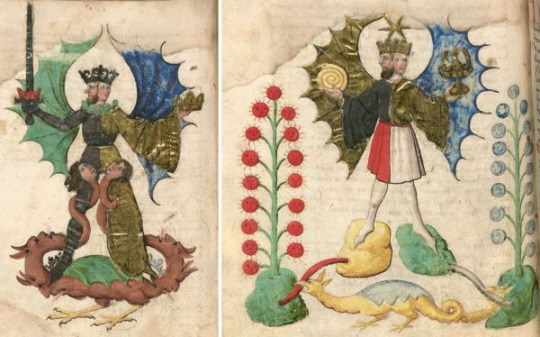
The first chemical wedding is usually somewhat violent, primitive even, whereas the second one signifies the creation of the stone. However, characters can have more than two weddings, and chemical weddings do not inherently have to be romantic--Sam and Frodo aren’t, for example--but most often are, because it’s the most obvious way to show a union between separate people (the old adage “two become one” in marriage, for example).
If we look at George Ripley’s 12 Gates, chemical weddings tend to be focused on in the fourth stage of conjunction (which I wrote about here) and in the ninth, fermentation (which is probably going to be in volume 10--maybe a little in volume 9, but traveling between worlds seems to be a hallmark of sublimation in fiction so I’m guessing we’re stuck there for the time being). But in a lengthy series spanning eight years and counting, there is going to be overlap.
So let’s talk about chemical wedding imagery historically. It tends to involve dissolution (via water or fire--keep in mind metal was associated with fire in olden days, so stabbing with metal was considered liquid fire, or so it was believed to be by alchemists) and then coagulation (healing/coming together).
Four of the five ships--two of whom are definitely happening, one of which I think is happening and one of which I think has a good chance--reference historical alchemical artwork and symbolism in key moments. (RWBY does reference alchemical artwork; see here and here.) So let’s dive in and examine potential chemical wedding allusions in RWBY:
Lie Ren/Nora Valkyrie (Renora)
Let’s start with the most obvious couple: Ren and Nora. Their first chemical wedding occurs when they are children. In alchemical art, birds are often used to show the volatility/primitiveness of a first chemical wedding:
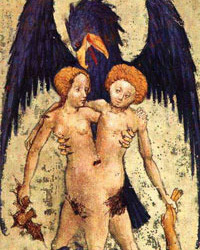
The raven is replicated in the Nevermore which forms a similarly threatening pose over Ren and Nora when he unlocks his semblance to protect her, thus honoring his father and mother’s legacies.

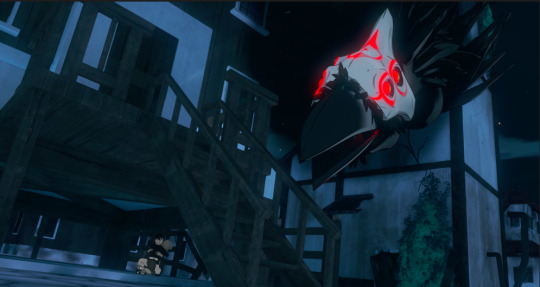

You can even see earth (trees), water (river), fire, and air (the bird flying) in the scene as it pans out. After this, Ren and Nora become “Ren and Nora,” as Nora herself says in Volume 8. They’re inseparable, because they’re on their way to becoming one. However, unification doesn’t mean that they’re literally the same person; in stories like these, it’s more like they become better versions of themselves through growing towards each other and adopting each other’s traits (like Nora’s courage for Ren, and Ren’s caution for Nora).
Their second, elevated chemical wedding is in the same place as their first, when in Volume 4 they return to the village and defeat the monster they were too young to defeat last time. This time, Nora is the one who protects Ren by telling him he could not sacrifice his life by pulling Ren back, in a reversal of his running to her in their first moment years ago.

Like the first, there’s water involved--Ren and Nora hide next to a river, watching as the Knuckelvee advances on them. I talked previously how I thought this looked like a possible allusion to this alchemical image (look at the moon symbol on the head of the aggressor):
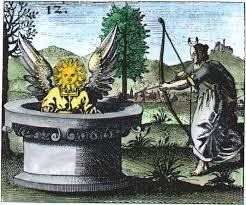
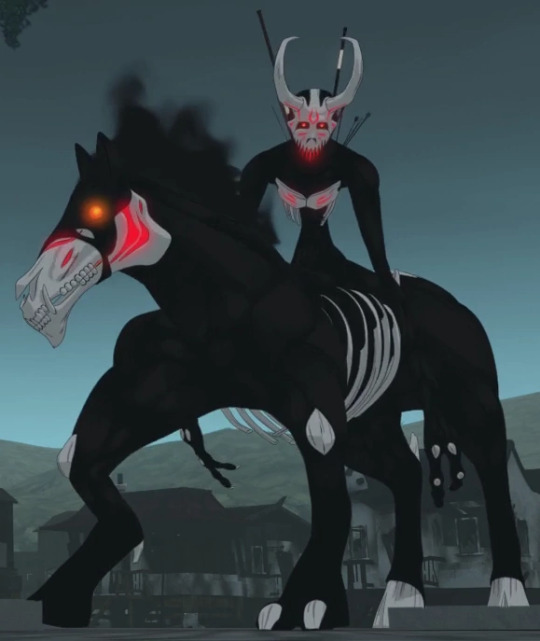
The moon symbol actually shows up quite a bit in this scene, first when Nora and Ren discover the Nuckelvee is still alive in the cave:

And then in the moment when they defeat it:

While I am certain this is a chemical wedding, I’m not certain why the moon symbol is so prominent in this, though I do think it is possibly in reference to this image and how Nora and Ren are united now:
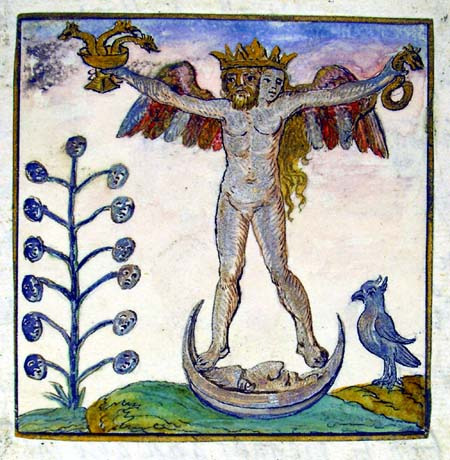
Yang Xiao Long/Blake Belladonna (Bumbleby)


Firstly, the alchemy image is somewhat of a creepy image, right? In this, Mercurius has united the two principles by beheading them (amputation is a Thing in alchemy), leaving them to putrefy and then coagulate.
Like the Nuckelvee for Nora and Ren, Blake and Yang have a somewhat antagonistic Mercurius who unites them: Adam Taurus. He doesn’t cut off their heads, but he does seriously injure Blake and cuts off Yang’s arm in a scene that is romantically charged (you have Blake’s possessive ex telling her he’ll target someone she loves and specifically chooses Yang).


While I have my issues with how Bumbleby is written, it’s hard to interpret that as anything other than him seeing Yang as a rival for Blake’s affection.
Their second chemical wedding also involves Adam. There’s no one direct image that seems to have inspired it, but it does take place in a place full of waterfalls (fountains and flowing water in general, like the ones in Nora and Ren’s village, are common elements of chemical weddings’ settings) and by the ocean (the “mercurial sea” is where the elements dissolve to make the Philosopher’s Stone, so it’s also a common hallmark for chemical weddings).
(To briefly address this: this is where my complaints about the writing pile in, because you can also make a damn strong case that Blake and Sun fighting on the ship to Menagerie is a chemical wedding, which it is, but I think it’s clear at this point that Bumbleby is endgame. Either both were written for a reason, like if they weren’t sure if they could do Bumbleby, or a narrative reason, in which case Black Sun should have been dealt with rather than hand-waved away, or they were just teasing, but baiting fans is never, ever good writing; it’s cheap. All that to say that while I think there’s a compelling case they were interested in pursuing Bumbleby from the start, Black Sun shippers have a right to feel tricked and not all criticism thereof is based in homophobia or a lack of narrative understanding, or even in a dislike of the ship.)
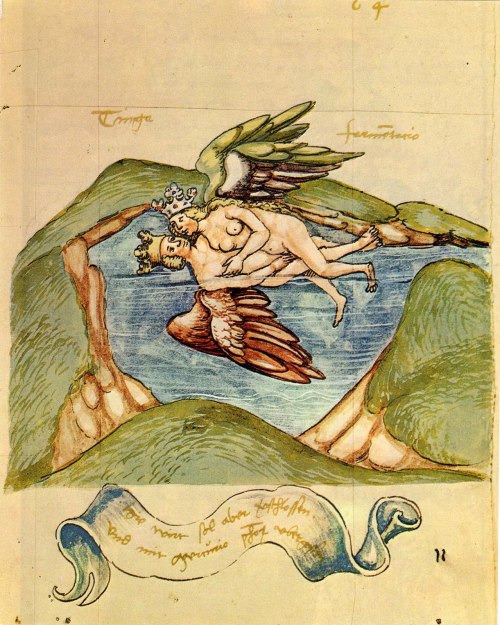
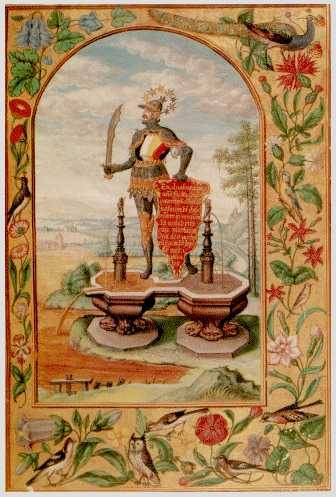

At the beginning of this scene, Adam makes it clear that this is a redo of their previous chemical wedding by reminding them of it:


Blake stabs Adam with a silver weapon; Yang with red. We have earth, air (clouds), water, and weapons as a stand-in for fire.
It’s still somewhat of a violent wedding, which makes me wonder if Bumbleby will have a third (and Renora as well). But it also parallels Renora in this: returning to a pivotal scene where they were traumatized, but this time being able to overcome it because they’ve become more like each other. Blake is in many ways Yang’s trauma stretching far beyond Beacon (Blake runs away, as does Raven, Yang’s mother who abandoned her), and likewise Yang for Blake (she’s hotheaded and holds grudges, like Adam). But Blake and Yang have been working on becoming better versions of themselves.
At the end of this scene, they even exchange quasi-wedding vows (since Blake’s promise is to not abandon Yang):

And the artists drive home the point by drawing Blake’s hair far bushier than normal (more like Yang’s), and Yang’s far tamer than normal (like Blake’s).

Jaune Arc/Weiss Schnee (White Knight)
Weiss and Jaune have had one chemical wedding thus far (possibly two but not sure) and I didn’t ship them at all until I saw this scene. Like Bumbleby and Renora, they have an antagonistic Mercurius: Cinder.
(This one I’ll be arguing a little bit about why I think it’s set up for romance as well.)
In this scene, Cinder directly compares Weiss to Pyrrha in regards to how Jaune feels about them (and we know Jaune and Pyrrha were romantic--you can also argue Cinder was an antagonistic Mercurius uniting Pyrrha and Jaune).

When Weiss screams, Cinder gets an idea and slides her gaze from Weiss to Jaune.
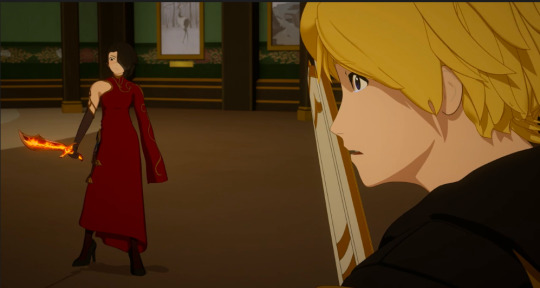
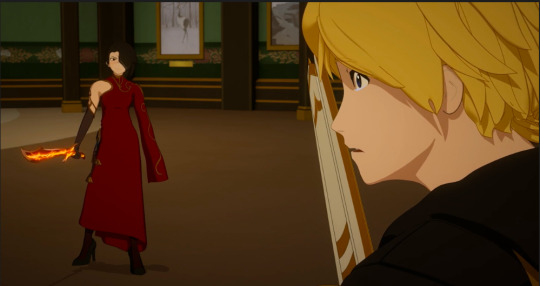
And then reenacts this:
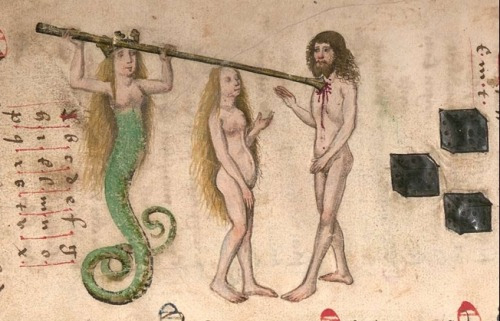

As I also mentioned previously, Jaune then plays the role of the Prince to Weiss’s Snow White (which is an alchemical fairy tale). Like when Ren unlocks his aura to protect Nora, Jaune unlocks his to save Weiss. Weiss looks as if she is in a glass coffin that gets more and more golden, symbolic of refinement.

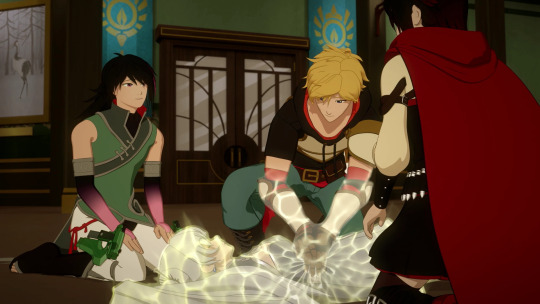
It’s also probably an allusion to this image of a chemical wedding presided over by Saturn (Mercury in this scene, since he’s there) and Death (Ruby and Qrow, who are also present in the scene with Jaune and Weiss). (For more on this image, see here.)

Weiss and Jaune also have some oppositional imagery and arcs: Weiss starts Beacon with a deep family legacy and an inherited semblance, she chooses to go to Beacon on her own and is the favored child (at first). Jaune too has a family legacy of warriors, but instead of feeling empowered because of this, he is insecure and literally cheats his way into the school. He doesn’t have a semblance until season 5. After this incident, Weiss and Jaune spend some time recreationally together (seeing a movie in vol 7); Jaune becomes more confident as a leader, and Weiss continues her arc in becoming more sympathetic to those from less privileged backgrounds.
Arguably, what happened at the end of volume 8 could be seen as having some symbolism of a chemical wedding for Weiss and Jaune too, but I don’t think it actually is one since they weren’t focused on as characters enough (if this was intended to be the start of one, we’ll get something next season, I’d imagine). The only reason I’m mentioning it is because it does function as an inverse of the previous one, which is the case for Renora and Bumbleby’s first and second weddings too. Cinder again almost kills Weiss (she falls in the exact same position as in vol 5), but Jaune saves Weiss when he screams after killing Penny. Instead of saving Weiss by healing, he kills. There’s also some distinctive red and white imagery.

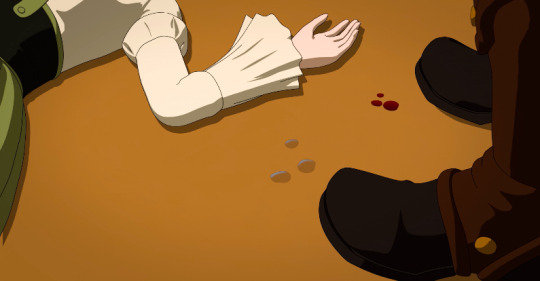
And then Winter arrives with a six-pointed star and birds before telling them to run together:
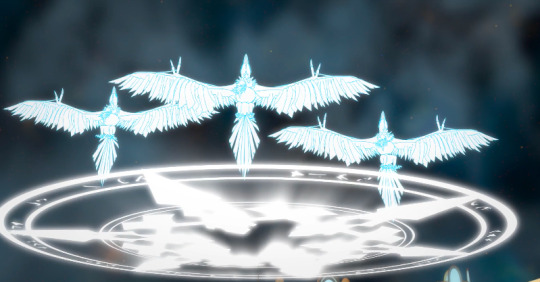
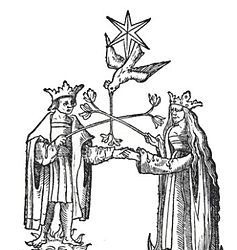
But again, I wouldn’t really call this one; it just has some imagery of one and fits a pattern, so I’m including it as a potential lead-in to an actual one in the void or later.
Ruby Rose/Oscar Pine (Rosegarden)
Like with Weiss/Jaune, I’ll be arguing a little bit about why I think this one is likely to end up romantic, too (for example, Cinder most recently in volume 8 used Oscar to taunt Ruby in a callback to using Pyrrha and Weiss to taunt Jaune).
Also: oh look, finally a wedding that isn’t violent. They just... meet. Which is also normal for a chemical wedding but less dramatic.
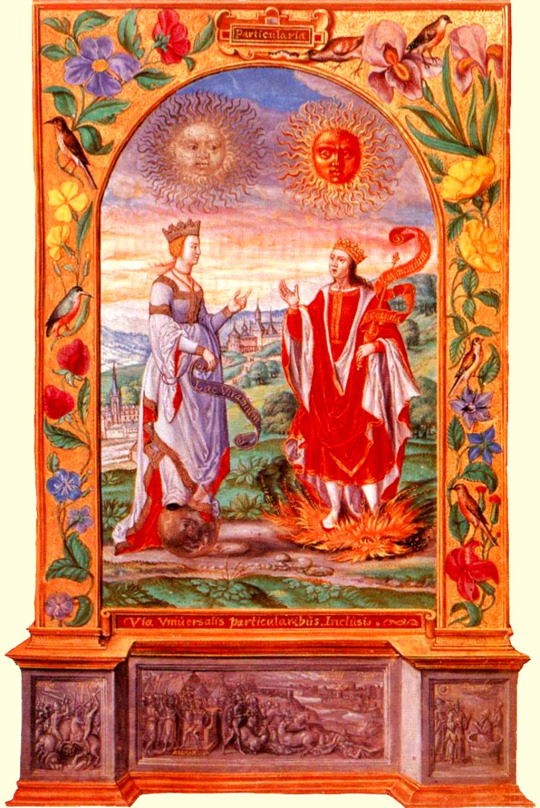
Behold, the bird uniting the solar king and lunar queen:

(Fun fact: unless CRWBY came up with ship names which I highly, highly doubt, this is pure coincidence, but it’s a funny one: the art series this image is taken from is called Rosarium Philosophorum--which literally means “rose garden philosophy.”)
Let’s look at the scene where Ruby and Oscar meet for the first time. What makes this a chemical wedding is in part how obvious their markings are and the overall imagery is in the scene.
They are united by Qrow (who in addition to being named after a bird can literally transform into a bird):

Oscar asks about Ruby specifically (yes, I know because Qrow’s her uncle, but the writing is telling us to focus on his relationship with her):

And immediately notes/is in awe that she has silver eyes (i.e. the moon):
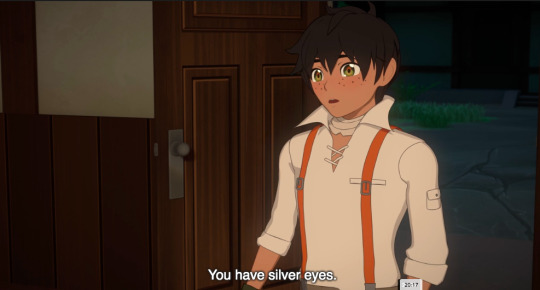
Qrow seems to realize he’s done something momentous in a way that almost doesn’t entirely work within the frame of the narrative (but he is drunk, so).

The scenery of this room is also telling. The table is literally an Emerald Table, the legendary foundation of alchemy itself.
Once they sit and talk, behind Oscar are the elements of earth and water, which he represents, and also the moon, which while traditionally associated with earth and water, he does not (at least not as strongly as he’s associated with the sun/gold):

Similarly, behind Ruby we have the elements of fire and air (like, if you zoom in, they actually drew air), which she is marked as, and the sun, which again, she’s not as strongly associated with as she is with the moon:

In Splendor Solis, which CRWBY has referenced before, the Solar King does eventually end up grounded in the moon, and likewise the Lunar Queen in the sun:
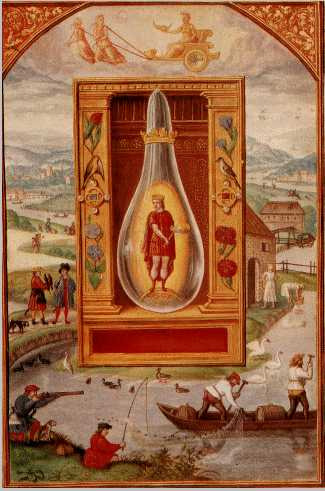
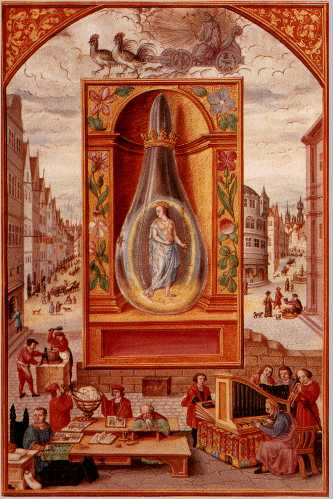
Oscar and Ruby also do have oppositional arcs and roles: Ruby starts the series in the very first episode by being invited to Beacon two years early because of her leaping into action to stop Torchwick. She’s scolded for her recklessness, but immediately picked out as special because of her silver eyes. In contrast, Oscar is reluctant to leave his farm once Ozpin inhabits him; he refuses at first, and then once he does leave, is nervous and timid.
Anyways I wouldn’t be surprised if Qrow arrives in Vacuo with RWBYJ in tow and this time reunites Ruby with Oscar in an inverse. We’ll see.
I do want to say that I also see potential for Emerald Sustrai/Mercury Black, in that they often act as one and share a theme song, but I haven’t seen any actual visual references to a chemical wedding for them... yet.
#rwby meta#rwby theory#rwby volume eight#rwby vol 8#rwby volume 8#rwby volume 9#weiss schnee#jaune arc#ruby rose#blake belladonna#yang xiao long#lie ren#nora valkyrie#oscar pine#alchemy#rosegarden#bumbleby#renora#white knight
156 notes
·
View notes
Text

Project Summary: Travel with a few members of the team here at BCC as they sit around a bonfire and reminisce on the days of summer. We will tell you interesting stories about tales that may be a little exaggerated about the members of a group of 7 guys that we have come to love.
Links to stories and edits will be added as they are posted!! We will reblog the stories and edits as well~ We hope you enjoy!

Seeing each other was honestly a dream. It felt surreal to be able to meet up and camp with so many people from an online network, and they were smiling and laughing as they talked in person (some for the first time ever). The lulling sounds of the ocean waves became a white noise to everyone as they set up their tents and gathered firewood. They were having so much fun talking together that time had passed quickly, evening fast approaching and the sun sinking into the horizon creating a sea of colors in the sky. The sight was truly breathtaking.
Simi’s and Lillia’s eyes locked onto the waving group down the beach. “Welcome everyone,” Alexis smiled as she returned to the campsite after scoping out the beach.
“Hey Alexis! How’s the beach look? Any shark teeth?” Lillia asked, returning to chopping onions in preparation for dinner.
"You say that like she'd know. Are we forgetting that she's the ‘blind’ one?" Simi replied, snickering at Alexis's squint.
From the small crowd gathering on the beach came a range of different accents. Some were easily pinpointed and others a little more difficult to locate. Lillia continued guiding everyone down to the beach, within the group was a small and rather tired Jester with a large bag. Situated at the bottom of her bag was some sort of rolled up bedding.
“Excuse me, sorry I’m late, airport customs tried to steal my Vegemite” Jester called, eyes gazing straight past Simi’s shoulder. With no hesitation she dropped her luggage in the sand, kicked off her shoes and sprinted towards the ocean.
Halting mere inches from the water, she teetered, waving her hands and trying not to topple into the surf from her abrupt stop.
“Almost jumped in with my phone and your American paper dollarydoos” she shouted, racing back to the group.
Jester proceeded to empty out her pockets, dumping twenty and fifty dollar notes and her phone into her shoes and running full pelt back to the water. With a warrior cry, she dove into the ocean causing quite the splash before the water stilled ominously.
There was no sign of her — had she disappeared? An alarming amount of time went by and the group shuffled nervously before she breached with all the elegance of a blue whale gasping and flopping onto her side.
A few of the others joined Jester whooping as they splashed into the water, others set to tasks they thought were a little more pressing, like designating tents.
With what little sun they had left, they had managed to hold a few fun activities and lots of conversations.
As the sun finally set the sweet cotton candy colors in the sky darkened and from its depths emerged twinkling lights, the mood changed along with it. Food was tossed on the grill, the inferno causing the aroma to fill the beach. Everyone’s mouth was watering, excited to finally dig in.
Simi was trying to organize gluten-free buns on one side and regular on the other. “The veggie burgers have finished. I cooked them on their own so it’s all good. I’m about to cook the meat patties — last call for meat-free grilling” Lillia called to the group with a bright smile, expertly flipping the spatula in her hand and getting back to work when there were no complaints.
The large group slowly began making themselves plates of food and once everyone was situated, the group was silent for a brief moment before Alexis decided to strike up some conversation.
“...I think that would be a great idea, don’t you guys think?”
The sounds of wood crackling could be heard in the background. Sepha watched as the smoke turned into the black of the burning wood and then to the fire-y orange and undertones of red. It had only turned out that way when she watched as one of the women drizzled more fluid over the fire.
Looking to her left, she saw a welcoming smile and couldn’t help but feel guilty for not hearing the rest of what had been said.
“Sorry?” Sepha asked, watching as the rest of the group surrounding the fire laughed at her in confusion.
“What kind of scary stories are you into? You know… typical gory types or mystery, maybe romance—” Lillia repeated emphasizing the last genre.
“Murder mysteries are the most interesting…” At this, Amunet smiled at Sepha’s response and she couldn’t help but return it.
“I like romance! You know the ones where people just go camping to see the stars, and the moonlight and it just smells like chocolate and marshmallows.” All eyes followed the light voice which sounded across the fire, belonging to none other than Kyub. Gabi couldn’t help but share a hopeless shrug with Sepha, who poked at the fire with her long stick.
The fire gave a loud crackle, “Sounds nice...but with this kind of night when there’s no moon and just the sound of nature around you — it kind of makes you want to tell scary stories for the fun of it.” Alexis seemed to agree to Sepha’s last sentiment and continued roasting the marshmallow.
“You’re right, though. Just darkness and nature, makes me think of murder.” Bubbles started up again which only earned a dry chuckle from across the circle.
Mae spoke up for the first time, saying “morbid, but sure, what the hell” as she fidgeted with her own stick, apparently inventing something the campers could only assume was a s’more kebab. She seemed to struggle immensely considering the graham crackers didn’t have any holes in them for her stick. But they all watched, intrigued, as Mae continued stacking: cracker, marshmallow, chocolate, cracker, marshmallow, chocolate, cracker—
“What are you doing?” This time, the voice came from just outside the circle, Amunet was returning from her tent wearing a thick navy blue pullover sweater. She was looking at Mae’s invention with an arch to her brow but otherwise unphased.
“What does it look like?” retorted Mae, gently waving the kebab around for everyone to see which earned a couple of laughs from everyone as a graham cracker broke off. Mae’s resulting cursing drew even more laughs.
Lillia began to clap, “A’ight! Let’s start with some stories eh?” She looked around, giving everyone her signature friendly smile before settling on Sepha. “I think you should start some things off Seph, with you know, all that murder mystery enthusiasm you have.”
“Huh?” She was caught off guard, looking to see everyone anticipating eyes had fallen upon her and when she looked around the waiting company, she could see Kyub giving a soft encouraging smile. The nervous laugh bubbled out of Sepha's lips before she could stop it, and with a scuff of her feet against the sandy ground she was ready.
“I-um—you guys ever hear that phrase,” The cautionary pause gave Sepha time to think it over, “You ain’t Jiving man?” There was a quick shake of Bubbles’ head to her far left.
“I have no idea what that means.” Jester hummed stabbing at least twelve marshmallows with a long skewer-like-stick. Another culinary mad genius.
“It’s from the 70s, all that slang shit. Supposed to mean: ‘Is that the truth?’ Or at least the equivalent to it.” That earned hums all around as Sepha licked her lips, wondering how to start off her story. Mae and Jester smiled encouragingly as Sepha shook her head to focus herself before diving in.
“Well, that phrase kind of relates to this story...at least kind of...maybe...I don’t know,” Sepha watched as Mae grabbed at the remains of a broken graham cracker, her frustration obvious enough in the way she picked at the pieces but it only earned her a cheeky smile from Bubbles who was right next to her. “I’m sure you guys heard of the case of Ted Bundy right? You know, infamous serial killer.”
“He was fucking insane and not even handsome. I don’t even know what girls saw in him during that time.” As she spoke, Jester’s face twisted like she had bitten into a lemon and all Sepha could do was nod in agreement. She watched the fire again, poking at it and watching the ash burn up to the surface.
“Well...I’m gonna tell a survivor story. Her name was Carol DaRonch, one of Bundy’s survivors and—”
“We should call her Katie! For, you know, copyright reasons.” This time the voice belonged to Bubbles; it was soft but managed to grab everyone’s attention in time before they could all fully dive into the story. At her suggestion, Sepha nodded and chuckled, poking at the fire once more, sending an array of sparkle-like embers into the night sky. She quickly moved the toe of her boot just enough to not get any of the burnt ash on it.
Sepha nodded vigorously again and continued.
“Yeah...yeah let’s call her Katie…” she licked her lips once more and looked up to see the dark depths of the night sky there wasn’t a cloud in sight. When the group stared at the fire they could almost hear the sound of Marvin Gaye. The campers could feel the heat wash over them, in a way that reflected the heat of Florida.
“It was a college party...in the summer of 1974….”
“Okay, well that was dark. Interesting, but dark. I like it.” Mae had shifted from her seat on a log onto the dirt beneath, slumping with her back against the bark lethargically. Others nodded in agreement.
“Shall we lighten the mood with a happier story?” Bubbles asked, lifting her hands to warm them above the lively fire. It was quiet for a second before Mae spoke up again.
“I have one.” She changed her posture to sit slightly straighter when all eyes were on her. “It’s about a couple that got turned into fairies while camping in the woods one summer night.”
“Is that a drug reference?” Lillia raised a skeptical eyebrow.
“No.” Mae frowned.
“Knowing you, ‘turning into fairies’ could mean anything.” Lillia shrugged, earning chuckles from the group. The fire crackled just as Mae sent a sharp glare at the woman, but her lips betrayed her as they began to curl upwards at the teasing.
“My story has nothing to do with drugs— but it does involve magic.” This caught the attention of the crowd. “Did you know that fairies occupy many wooded areas around the world? Yeah, they tend to hide from humans, but in desperate times they can use their powers to recruit our help, just as they did last summer.
“It happened somewhere in the Rocky Mountains in August of last year…”
Those scattered around the fire were left captivated by the fantastical tail Mae had spun. They had even paused from their s’more-making escapades, each slowly contemplating the idea of fairies. Some eyed the surrounding area outside the camp, others picked up where they left off preparing more marshmallows for their delicious dessert endeavors. In amongst the slowly roasting marshmallows was one completely engorged in flames.
“Uh, Jester your marshmallow is on fire?”
“Yup, that’s how I like them” She grinned brightly with green eyes sparkling full of mischief as she blew out the fireball that had encased the blackened crispy confectionary that once resembled a marshmallow. She shoved it into her mouth and shouted “My turn!”
“I have a good one.” Jester’s sharp grin seemed to be hiding something. “Hold onto your hats, this one is from my trip to Greece. You must always be careful when you travel to another country because anything can happen.
“It started in Mykonos...”
“And that’s what happens when you meet strangers in another country. I should have learned from the first two times I went overseas” Jester shrugged “Wild stuff, though”
“Actually no” Gabi interjected, pointing her finger in a pause gesture while she collected her thoughts.
“Nope” Kyub’s eyes were wide; she blinked, once, twice in disbelief. Before she shook her head as if trying to rattle the thoughts back into place.
“That’s famously not what happens when you meet strangers in another country” Gabi continued her thought with a small sound of concern.
“Yeah, I’m with them — that is most definitely not what happens.” Sepha laughed as Jester looked up confused. “Most people don’t go home with strangers, though, so I guess you could be right.”
“I mean yeah, that one was my bad I guess” Jester laughed.
“Who’s next?” Amunet asked excitedly, wishing to listen to more of the nightly stories.
Kyub looked a little nervous but after taking a deep breath she was determined to unleash her summer tale by way of pictures on her phone. “Mine isn’t exactly a story, I have some photos that I took over the summer that I think really tell a story. It was in a cemetery” her voice was sweet and gentle.
“We would love to see!” Alexis smiled reassuring the young girl. Everyone seemed intrigued by the idea of the photos and how they would tell the story.
“It’s up to interpretation...”
“That is amazing, how did that even happen?”
“You know the saying, ‘a picture is worth one thousand words’ and you have two” Jester grinned “like he is keeping the flowers a secret or like the flowers are something he loves and cherishes but keeps hidden.” Other voices chimed in:
“It feels so sad.”
“It feels so jarring that the colour is stripped away.”
“I like to think the first image is kinda, like, wistful or reminiscing and then when he looks down it is the reality.”
The entire camp seemed hit with raw emotion. There was a collective look of disbelief and someone sighed “That is so well done.”
Everyone had finished their stories and games for the evening and numbers started dwindling as the late hour took the sleepy camp goer’s. They all were settling for the evening, tents and sleeping bags rustling in the background alongside the occasional giggle, whisper and yawn.
Rolling out the khaki green bedroll, was Jester looking small in the contrasting light from the fire and shadow from the night.
“Jester, where are you sleeping, do you wanna share a tent?” Gabi asked, deciding to offer a shelter.
“Nah, I got my swag, I’m gonna lay by the fire and watch the sky.” She laid back and squinted up at the stars. “You should visit my little corner of the world where the stars look like milk.”

Credits: Thank you @youarejesting for working on this masterlist and @kyub for doing the amazing banner! And thank you to all of our writers, editors and betas who worked hard on this project: @youarejesting , @kyub, @dead-starlight, @bubblebunnylia, @sweetnspicy93, @bussy-posts, @jiminniethemarshmallow, @moccahobi, @yourmoonchild1023, @jung-hoseok-s-airplane, and @hesperantha for betaing the masterlist!!!
#bts#project#masterlist#kim namjoon#namjoon#rm#suga#min yoongi#yoongi#kim seokjin#seokjin#jin#jhope#jung hoseok#hoseok#jimin#park jimin#v#kim taehyung#taehyung#jeon jungkook#jungkook#bts fanfic#bts smut#bts imagines#bts scenarios#bcc projects#bts fanfction#sitting around the campfire#hope you enjoy
15 notes
·
View notes